What happens if you Fast 5 Days and Walk 7 hours a day? (Patreon)
Content
Recently, I ate 30 eggs a day for a month to “bulk.”
<figure> </figure>
</figure>This was effective as I indeed became a lot bulkier. Along with the muscle I also gained a decent amount of fat. Then, I went to Belgium for the holidays and put on even more weight.
So, as a way to jump starting my weight loss, I wanted to see what is the most amount of fat I could possibly lose in 5 days? What I did was:
・Fast for 5 days
・Walk 7+ hours a day
・Cold exposure
Before picture
<figure>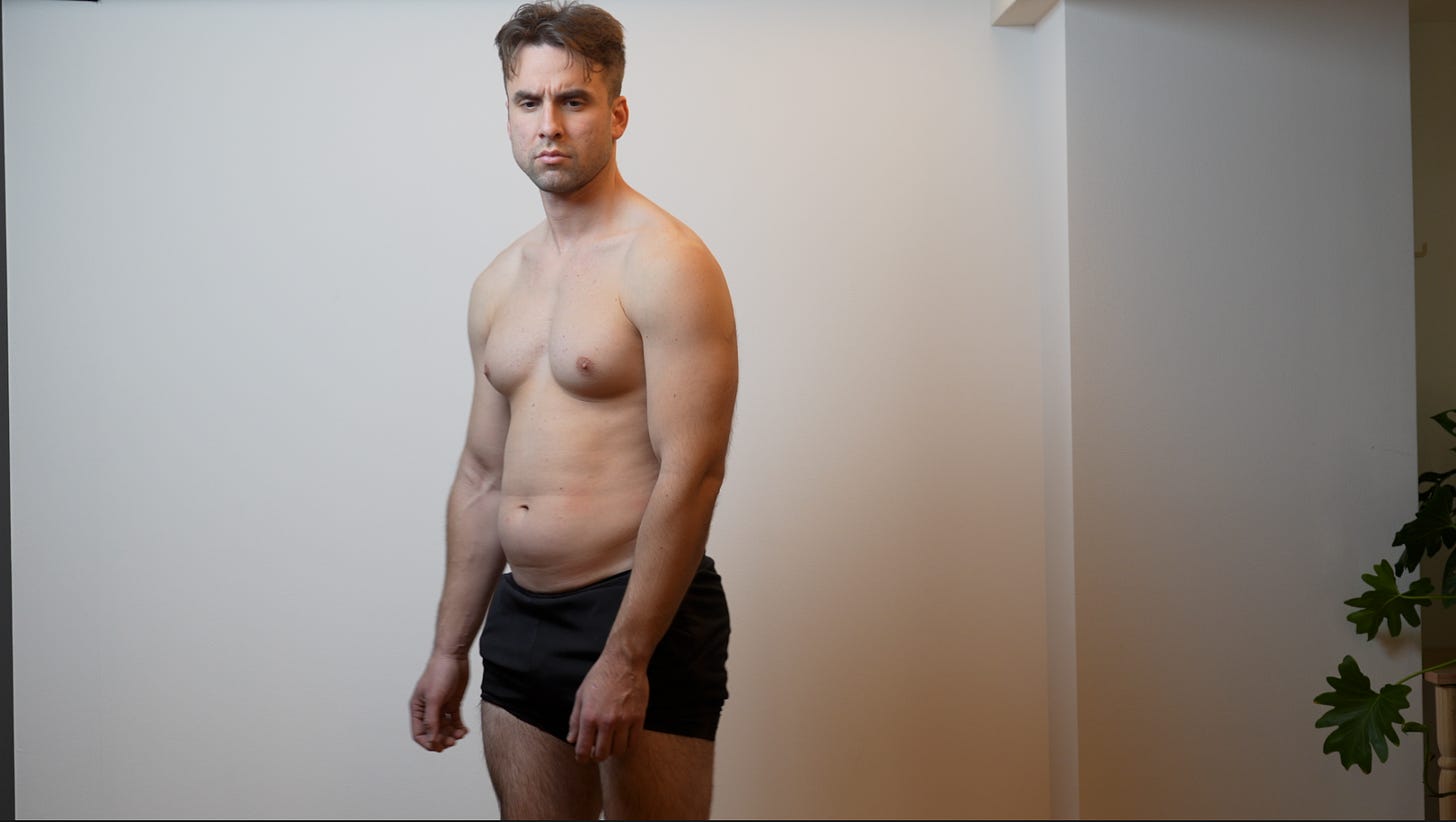 </figure><figure>
</figure><figure> </figure>
</figure>Over the 5 days I tracked my weight, mood, blood sugar, sleep, took several blood tests and I used a machine to check my muscle mass and body fat percentage. Here we’ll look at what exactly this fast did to my body, as well as do a deep dive into how fasting, exercise & cold exposure all synergize together as well as the debate over what “breaks” a fast.
Starting Weight
My starting weight was 84.9kg (187.2 lbs)
<figure>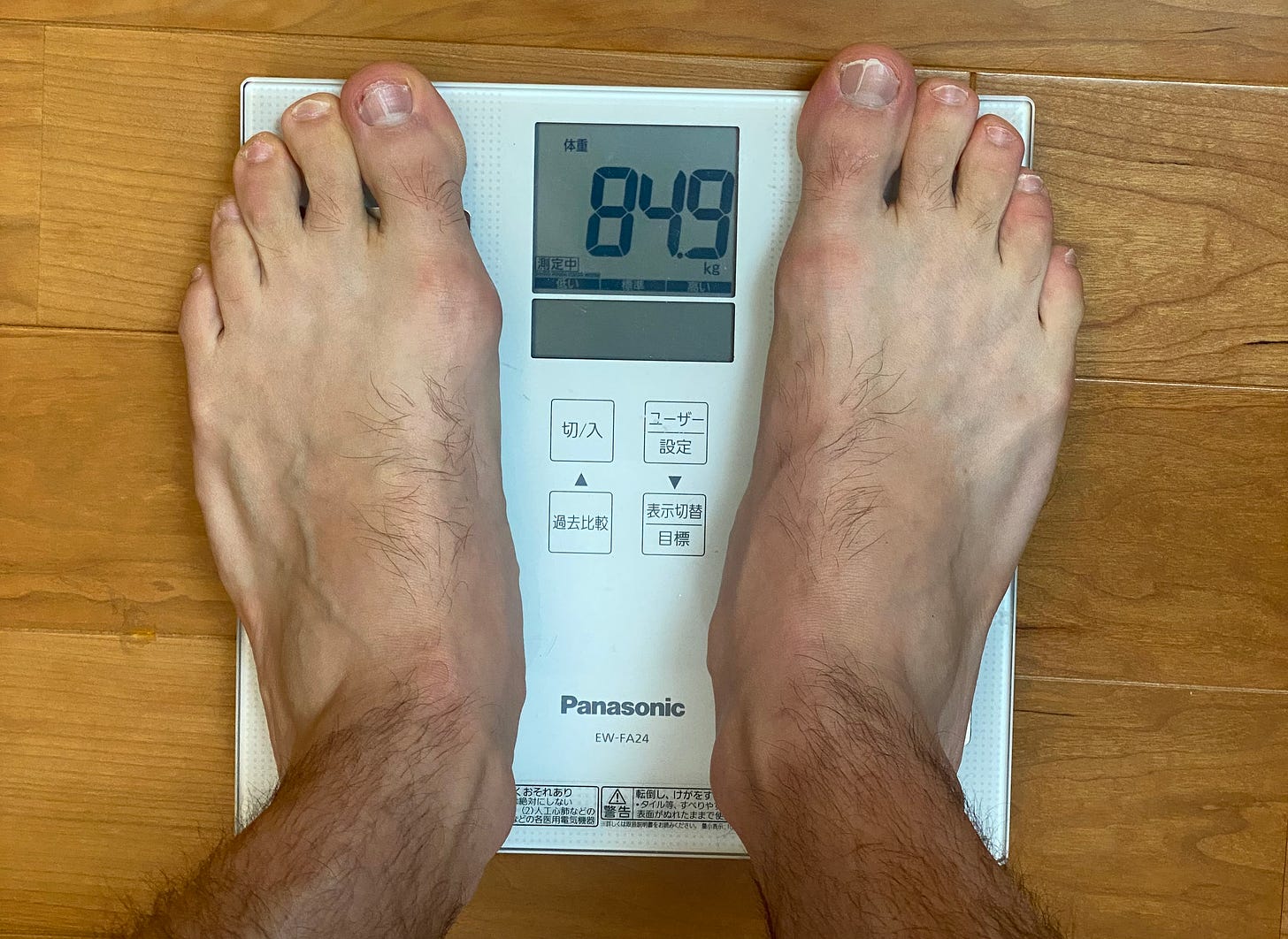 </figure>
</figure>I finished my last bit of food on Saturday at 1PM and snapped a before picture (above). Right away, I needed to get moving. It being the first day of the fast, I really wasn’t expecting anything too difficult.
I also did an InBody scan which is a Bioelectrical impedance analysis device designed to measure muscle mass, body fat and water content.
Starting Body Composition
・Soft Lean Mass: 70kg (154.3 lbs)
・Body Fat Mass: 9.9kg (21.8 lbs)
・Body Fat Percentage: 11.7%
Starting Blood Tests
<figure> </figure>
</figure>Insulin 4.5mcU/ml
Inflammation (CRP) 0.25mg/dl
Longevity Marker (IGF-1) 194 ng/ml*
Autophagy Marker (WBC) 6720 /mcl*
*I will explain these properly in a moment.
Day 1
I finished my last meal by 1PM on January 7th. Last time I did a long fast, I finished my last meal at night, meaning I would break my fast at night. I much preferred an earlier start and an earlier finish to my fast.
<figure>My flat foot.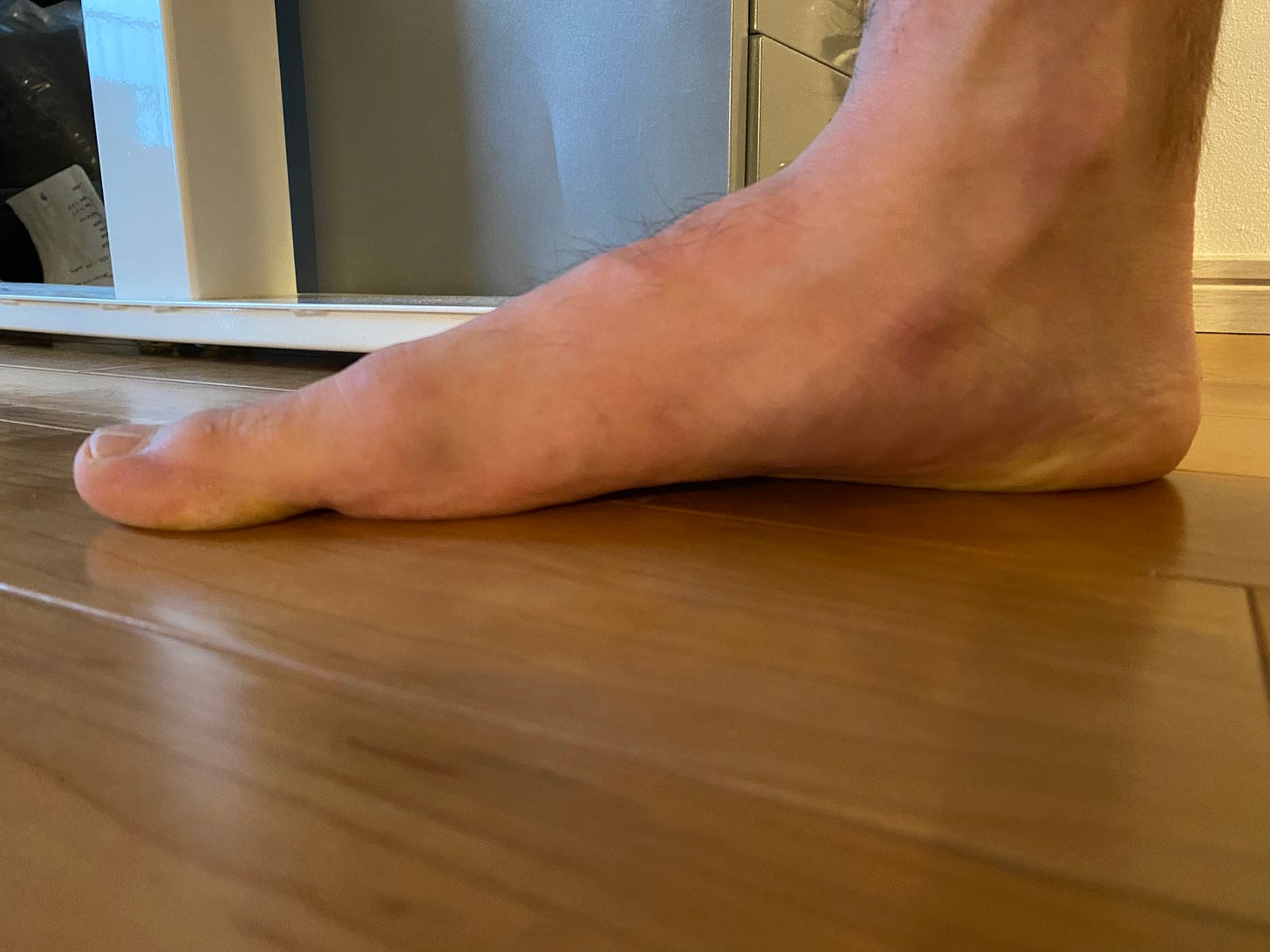 </figure><figure>My friend’s foot.
</figure><figure>My friend’s foot.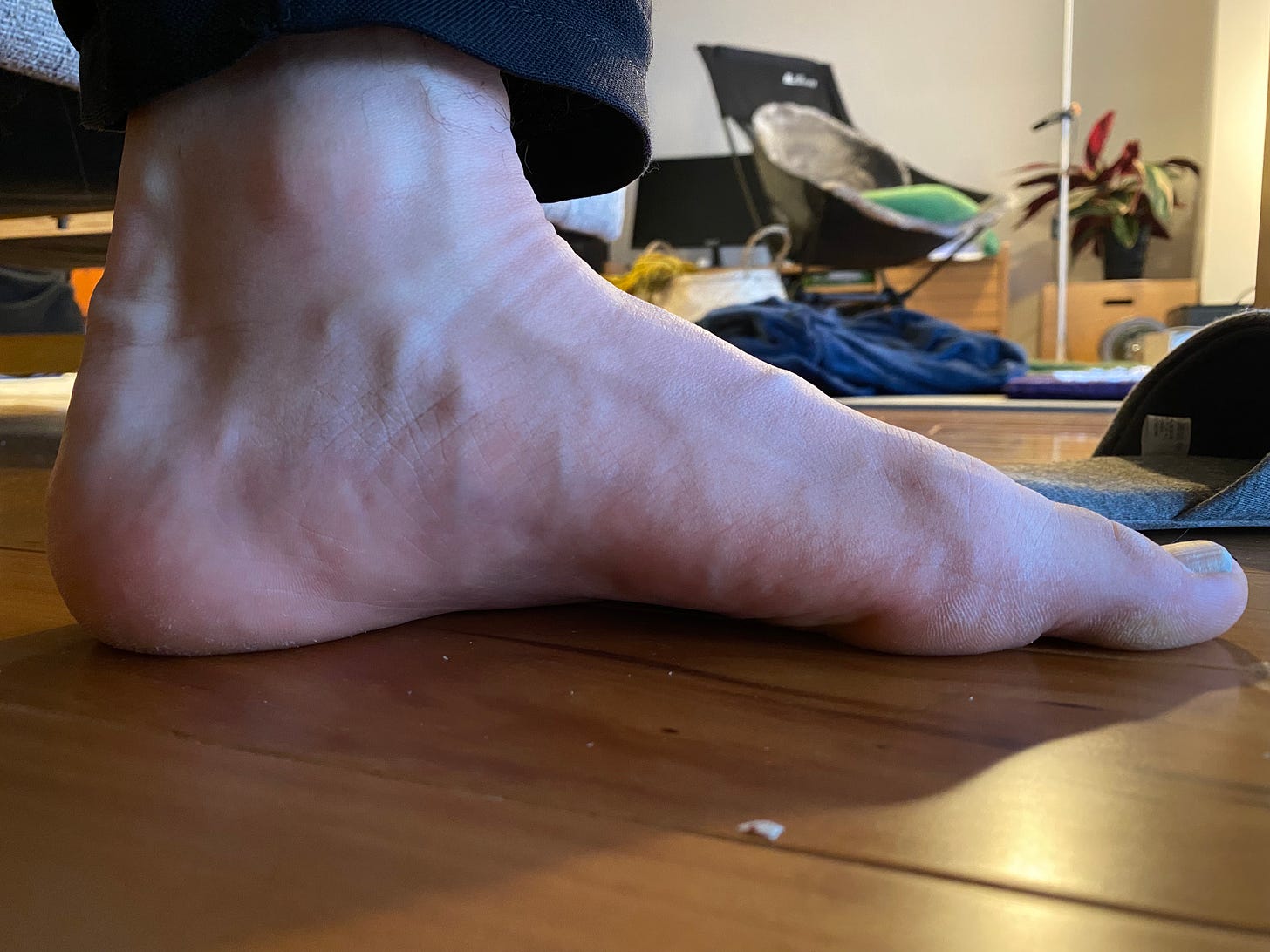 </figure>
</figure>I’m not actually the best person to be doing this challenge because I have flat feet - essentially the arches on my feet are collapsed so if I’m not careful, walking and running long distances can be really painful. (First picture is my flat foot, the second is my friend’s normally-arched foot). The first day I ended up walking 29,461 steps and was limping a bit by the end of the day but other than that it wasn’t too hard - surprisingly the hunger didn’t bother me much at all.
<figure>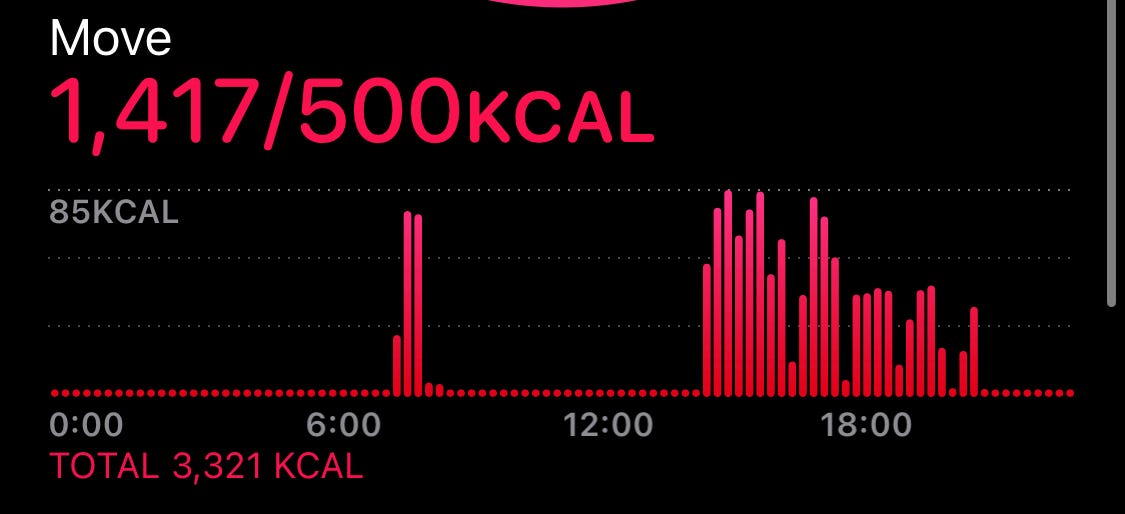 </figure><figure>
</figure><figure>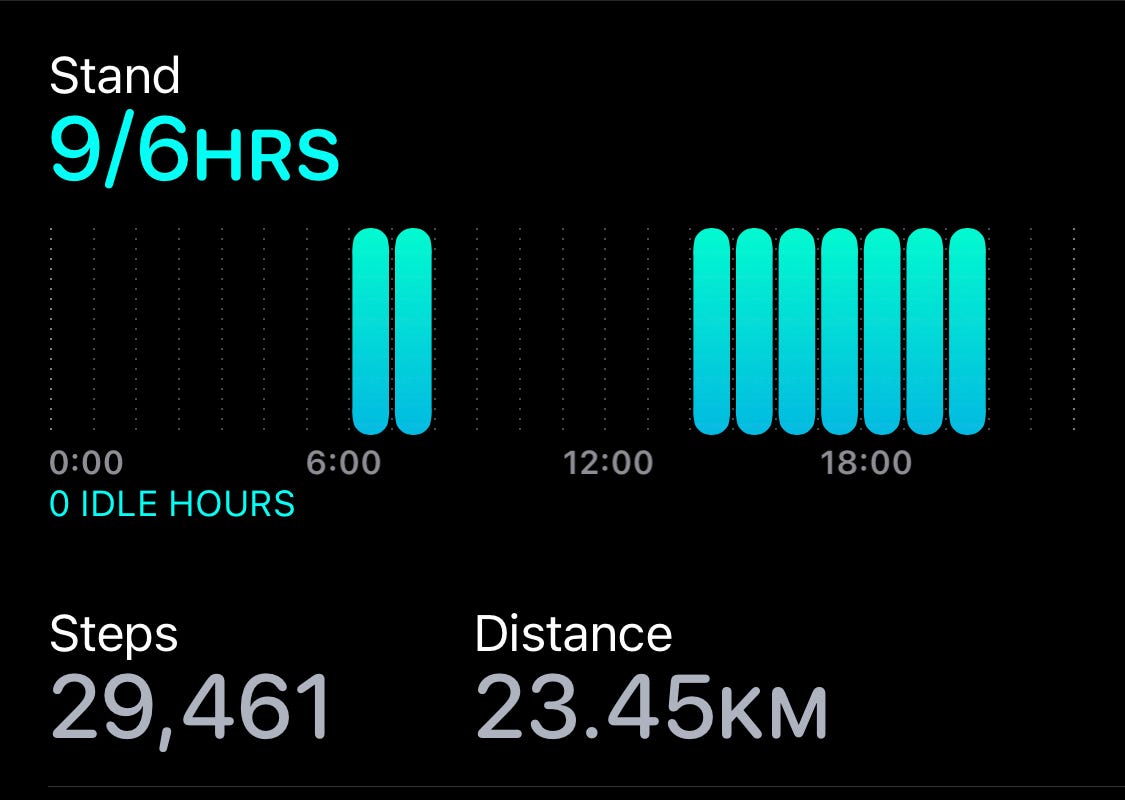 </figure>
</figure>The Growth versus Longevity Tradeoff
The annoying thing about being alive is that there’s this tradeoff between growth and longevity. Growth factors like human growth hormone and IGF1 help you grow muscles and lose fat, heal your wounds, regenerate your cells(R1,R2,R3,R4) and even grow new brain cells. However, studies on mice, worms and flies has found that decreasing these beneficial growth factors has them live 50% longer.(S1,R1) There are a number of people in Ecuador who have a genetic defect that makes these growth factors far less effective in them - unsurprisingly, they are much smaller than the average Ecuadorian, but they also are uniquely protected against diseases like cancer and diabetes despite having almost double the rate obesity.
<figure>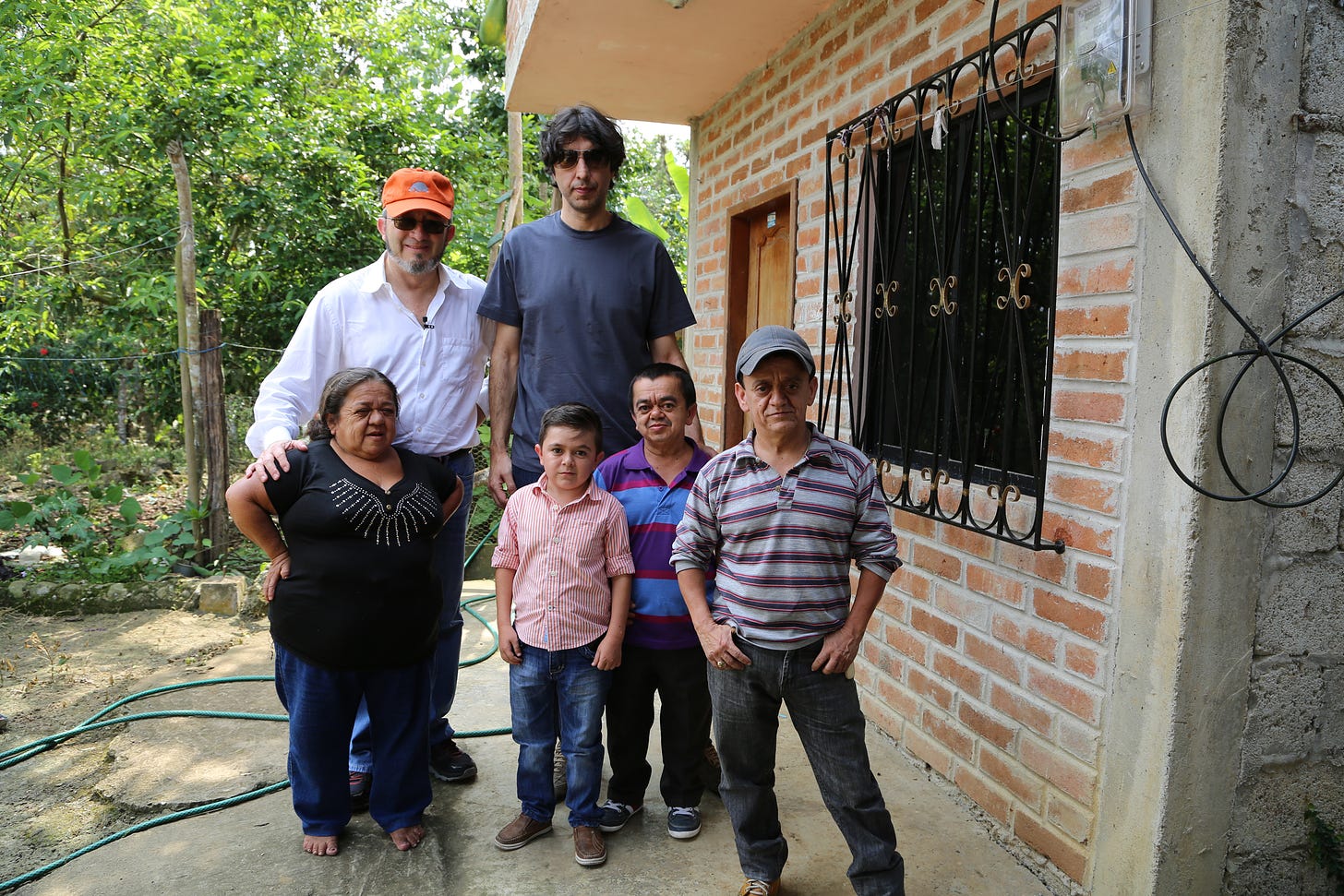 </figure>
</figure>Fasting is known to decrease these growth factors like IGF-1 (R2,R3) and research out of California found that this temporary reduction of IGF-1 through fasting increases your stem cells ability to regenerate (S1,S2,R1) and strengthens the immune system.
Dr. Valter Longo wanted to find a less painful way to provide the many benefits of fasting to people. He came up with a diet limited to 725 calories a day that mimicks several characteristics of fasting like an increase in ketones, a reduction in blood sugar and a reduction in the growth factor IGF-1.* His randomized trial on 100 patients found this fasting mimicking diet to reduce blood sugar, blood pressure and triglycerides as well as reduce IGF-1 and inflammation and increase blood stem cells.
*The fourth characteristic being an increase in IGFBP-1.
<figure>The Butterfield Diet Plan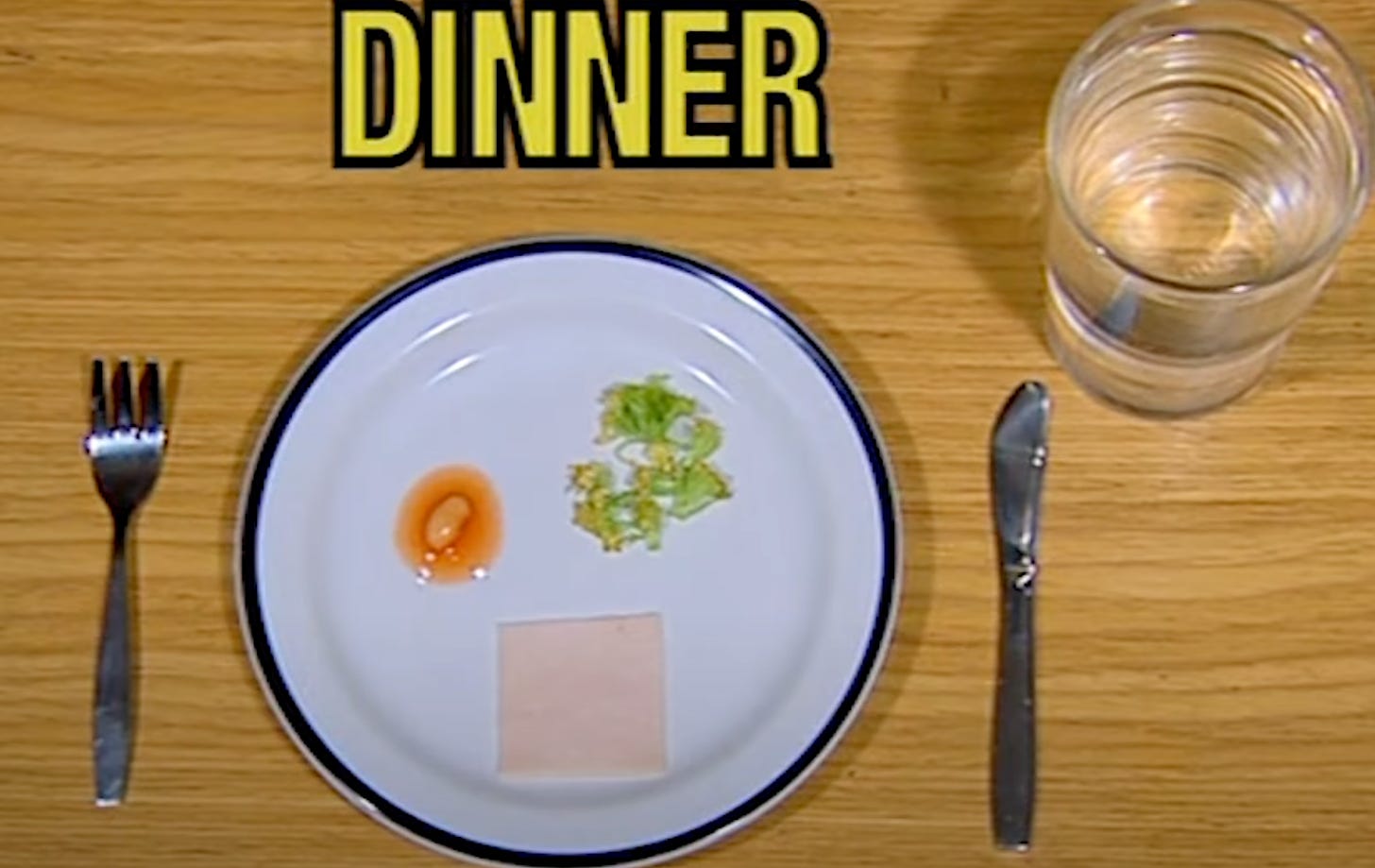 </figure><figure>
</figure><figure>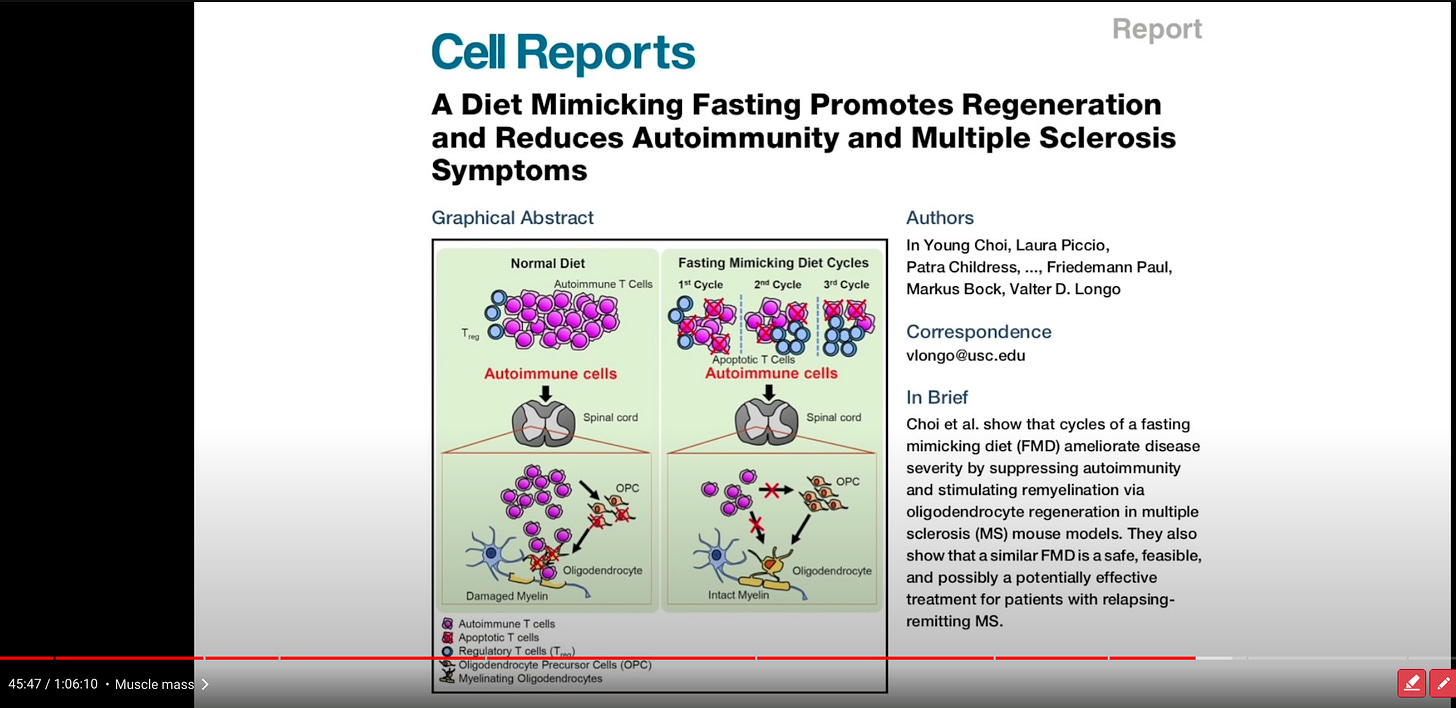 </figure><figure>
</figure><figure>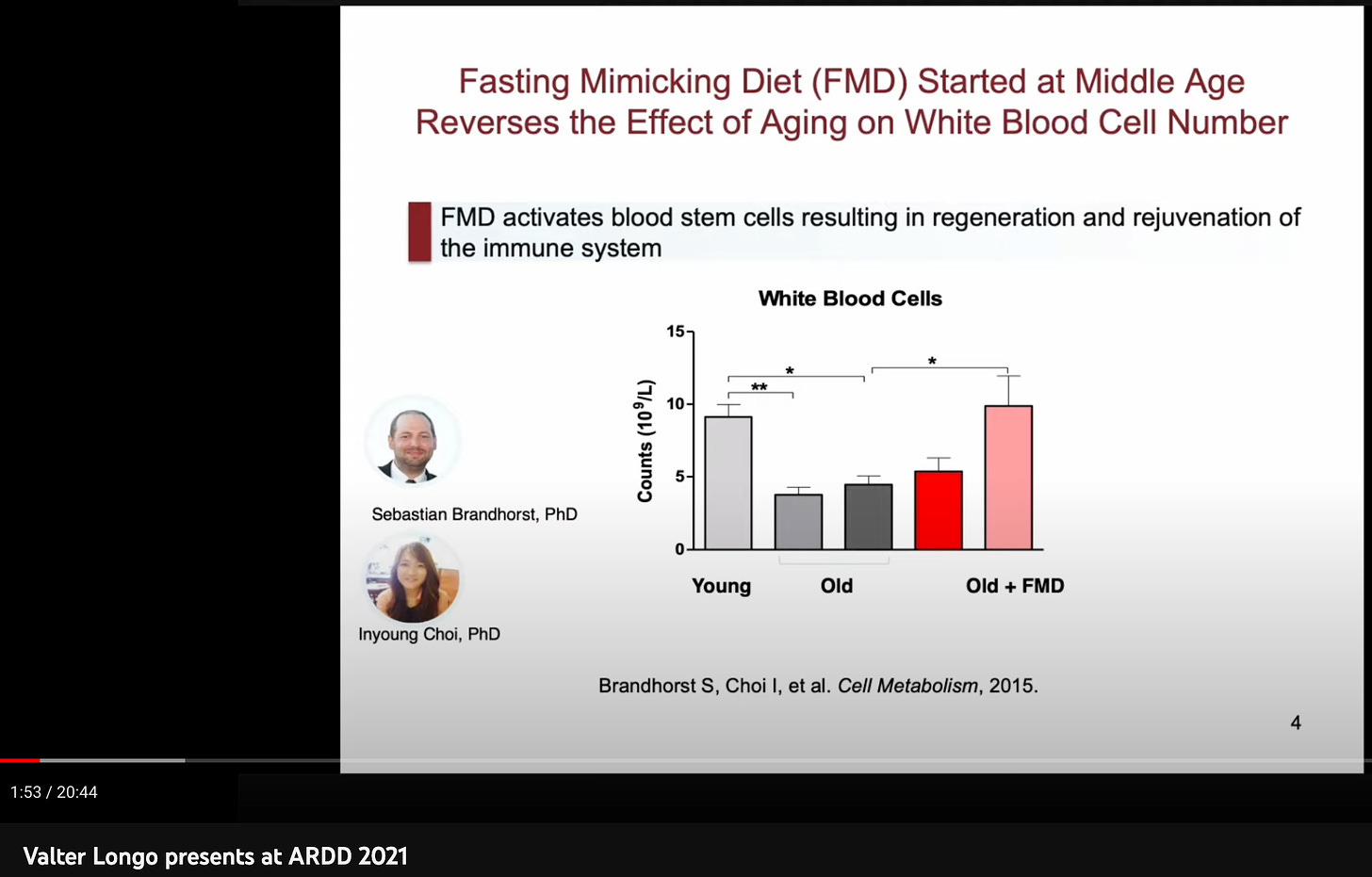 </figure>
</figure>Mimicking Fasting
I’ve done more than one zero calorie 7 day water fast, so I wanted to give this concept of “mimicking” fasting a shot. 725 calories seemed like way too much so I gave myself a budget of 300 calories from the second day. I focused on low carb, higher protein, higher salt snacks.
This takes us to the question of what breaks a fast?
<figure> </figure>
</figure>One good question is what is a fast and what breaks a fast and if you have cream in the coffee are you going to like, stop all the benefits? And the answer is no. You could take even up to like 500 calories and still get the benefits.
-Jason Fung
One of my reasons for doing this was to encourage people to be a little more relaxed with their fasts. People get very concerned about what “breaks” a fast to the point that they’re wondering whether toothpaste will break a fast. On the other hand, people want to know what breaks a fast so they can enjoy something here or there to keep them going. Can you have a coke zero? Can you have cream in your coffee? Can you have lemon in your tea? et cetera
<figure>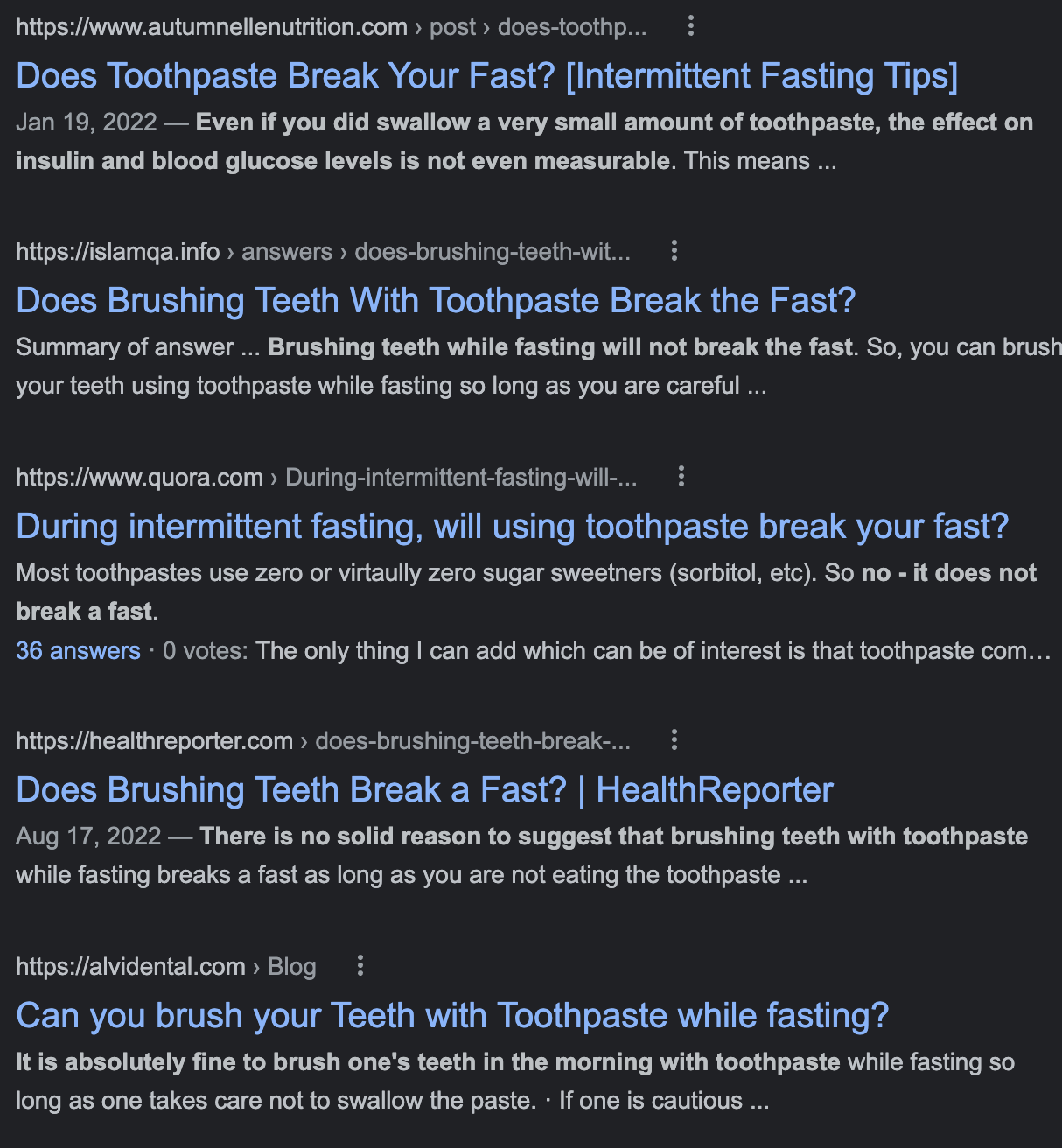 </figure>
</figure>The truth is, as long as you don’t eat something too carb-y like fruit or big gulps of honey, you have a fair amount of leeway; things like exercise and cold exposure should increase that leeway. Some of the processes that are making fasting beneficial will “slow down” (ketones will probably lower, blood sugar and insulin may go up a bit and if you’re eating protein, IGF-1 may increase) if you eat something. However, even if you eat a small teaspoon of honey 3 days into a fast, your body will quickly metabolize that small amount of food and get back into a low insulin, high ketone state relatively quickly.
<figure>Note on this image: RF refers to refeeding which is why you see ketone levels drop from RF1 through RF4.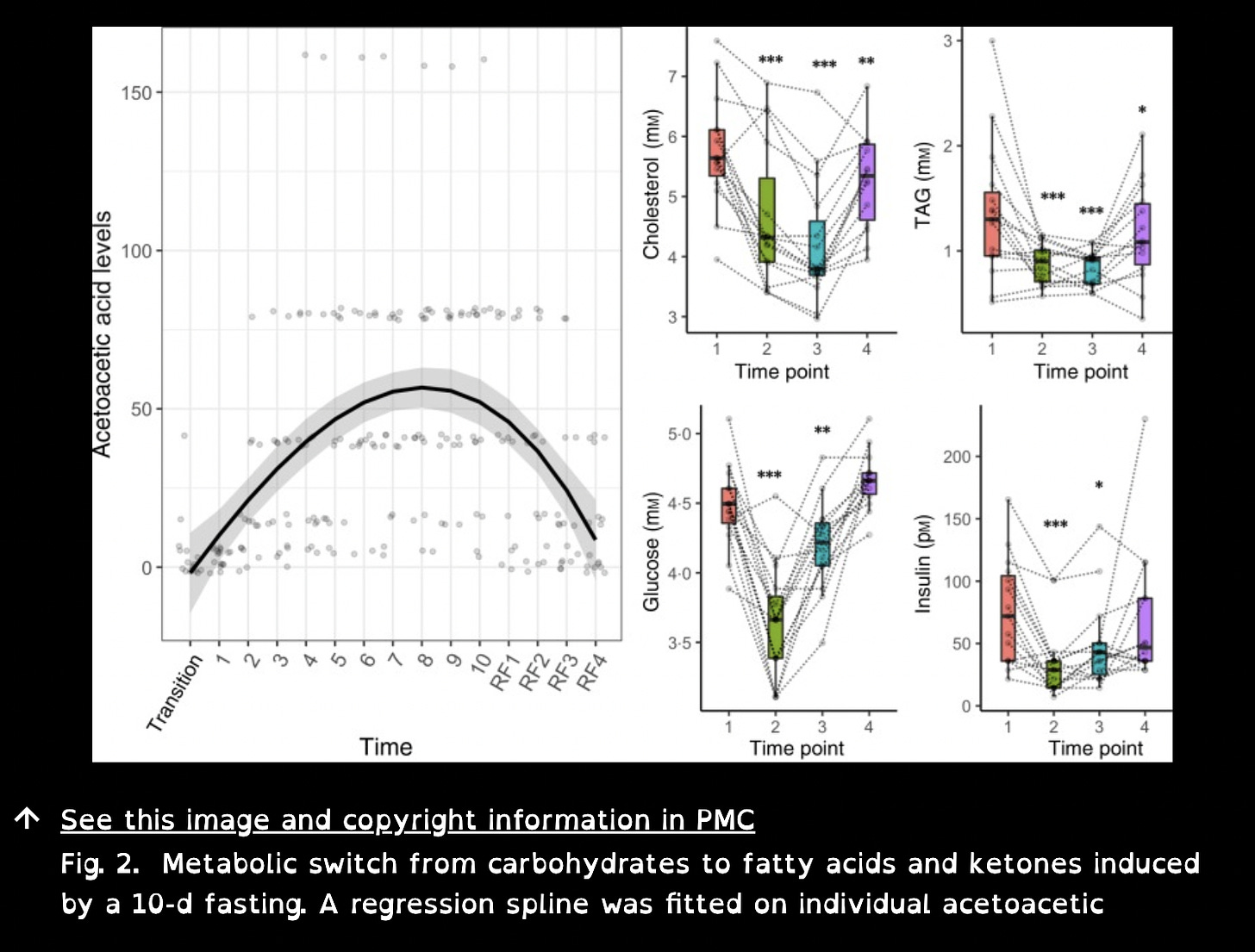 </figure>
</figure>Personally, 50 grams of pure carbs is the last thing I would want to have during a fast, but in this particular clinic they were giving patients 250 calories of pretty much straight carbs… and they still were in ketosis.
If you take a bit of cream in your coffee or you y’know mistakenly eat a little something, what happens is your insulin levels are falling, falling and yea they’re going to blip back up a little if you make a mistake, but then they’re going to start falling again. So no big deal. It actually doesn’t really matter.
-Jason Fung
So the point is if being able to look forward to a tiny lunch of some salty broth and salted pollock roe makes the fast easier, then it will probably be easier to do more fasts. While sure, a completely zero calorie fast will surely technically provide more benefits, doing two five day “mimicked” fasts a year is going to be better than one water-only five day fast.
<figure>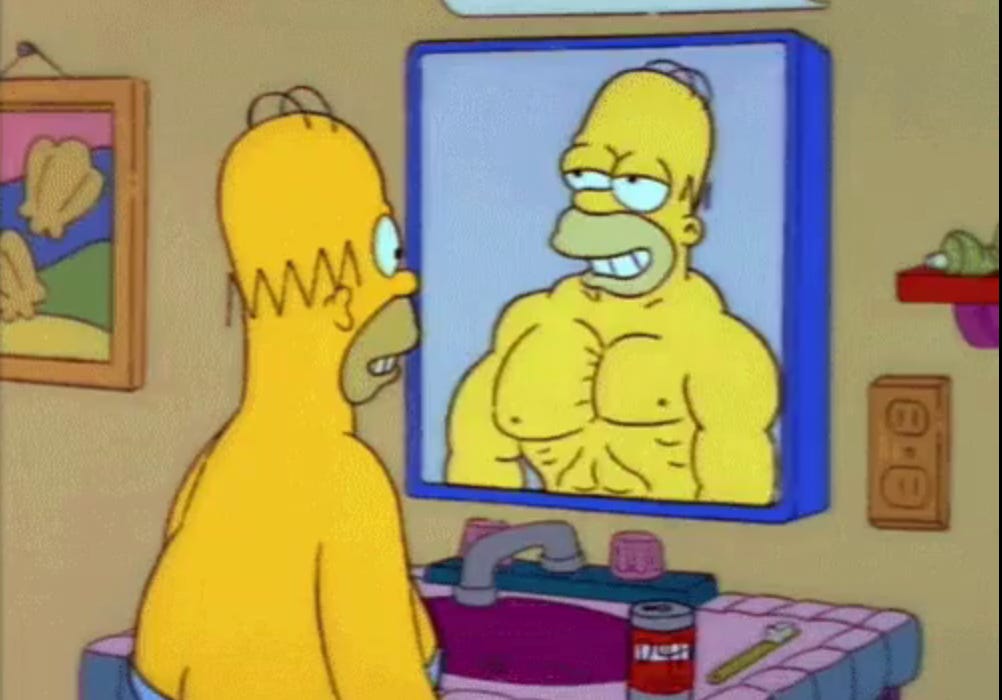 </figure>
</figure>That said…
I still wanted to make sure that these 300 calories were not interfering with what I was hoping to achieve from the fast. So, the benefits I was tracking were:
・Fat Loss
・A dramatic reduction in insulin
・A reduction in inflammation
・A reduction in IGF-1
・Any blood changes that would indicate more autophagy was going on*
*Recently many people are fasting in hopes of increasing autophagy, which is basically where the body rejuvenates itself by eliminating and recycling old and damaged cell parts.
For reference, here are my starting blood labs taken an hour before I finished my last meal.
 </figure><figure>
</figure><figure> </figure><figure>
</figure><figure> </figure><figure>
</figure><figure> </figure>
</figure>CRP (C-Reactive Protein) is a marker for inflammation. Somatomedin C is the term they use for IGF-1 here in Japan. In a video where Rhonda Patrick interviews Guido Kroemer, she presents on screen a paper that illustrates that a reduction in white blood cells may be an indicator that autophagy is occurring as this causes hematopoietic stem cells (an immature cell that can develop into all types of blood cells) to self renew and produce new blood cells.
<figure>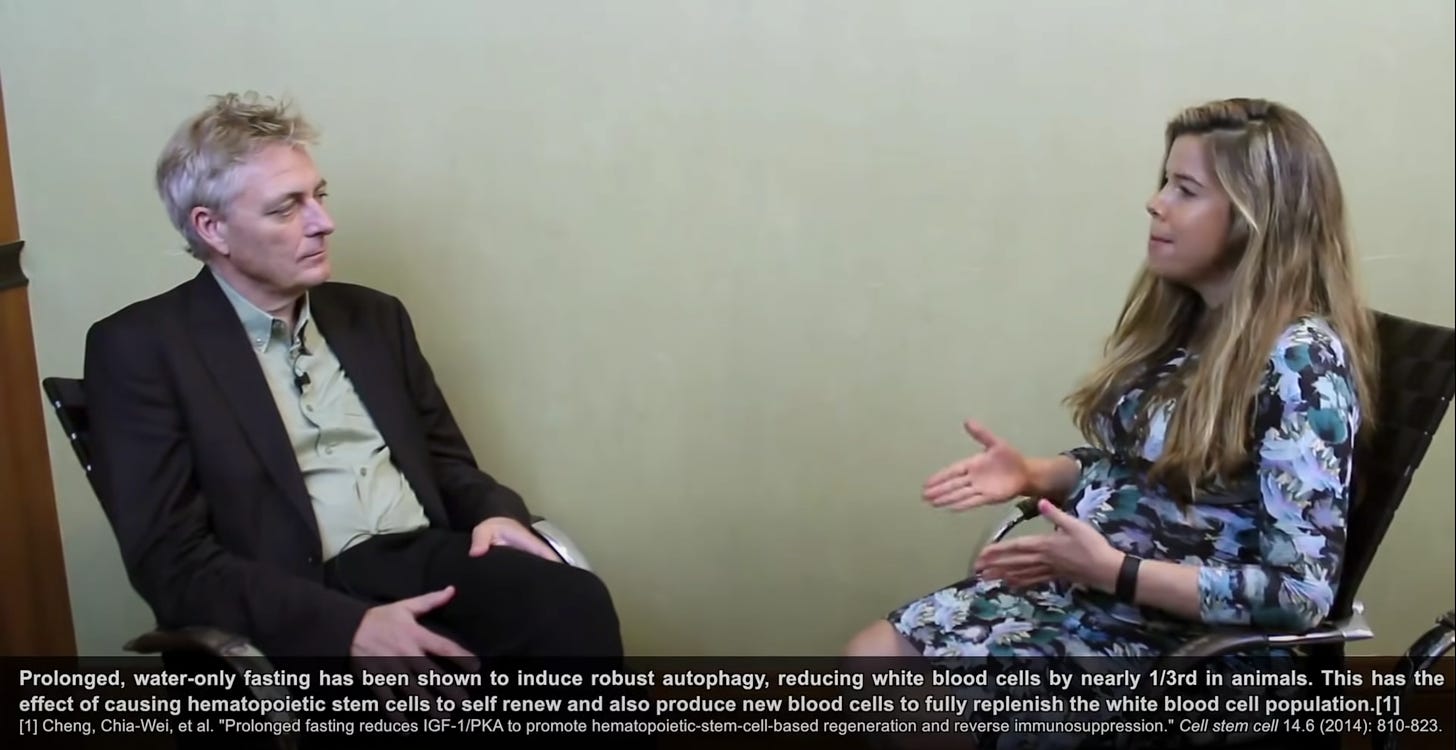 </figure>
</figure>Day 2
The second day I had the typical waves of hunger that I’d expect during a fast. They came and went like normal. What was surprising about this day, was that despite walking almost 34,000 steps (27km) and burning around 2000 calories from all this movement, it didn’t make me hungrier than I’d usually be on a fast.
<figure>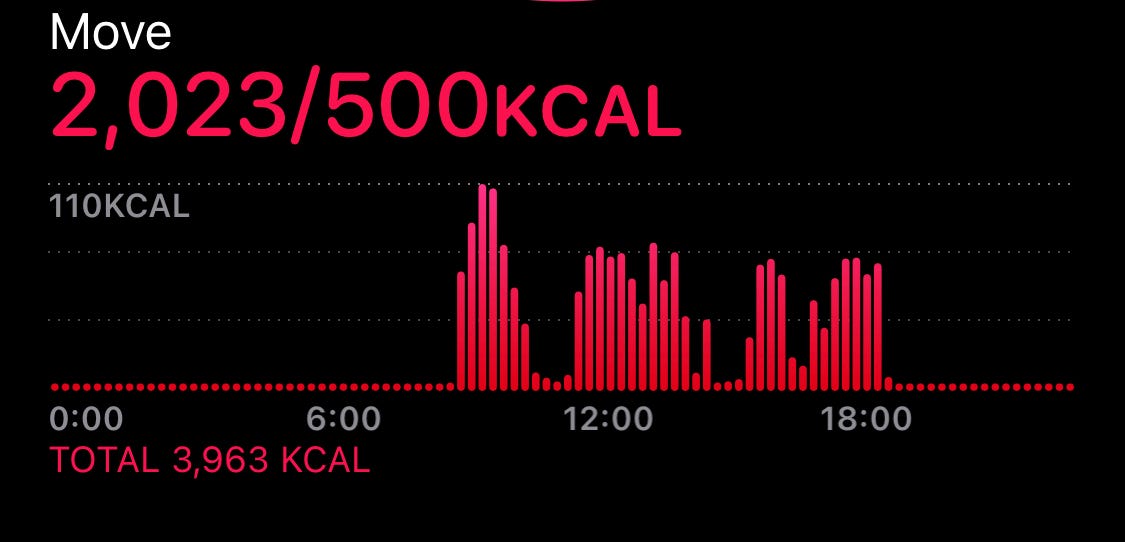 </figure><figure>
</figure><figure>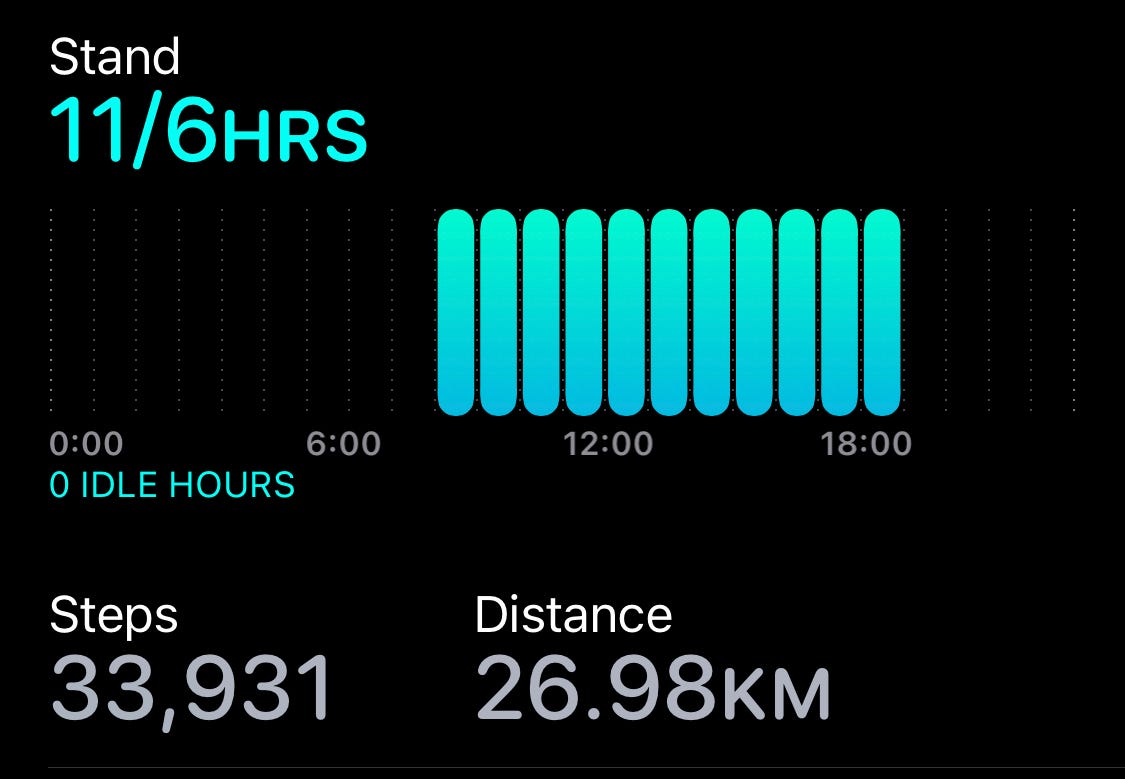 </figure>
</figure>In fact, the movement seemed to reduce my hunger. Not just in the way that it took my mind off the hunger, but if I was feeling any hunger pangs, they would mostly subside once I got in the sunshine and started walking around.
<figure>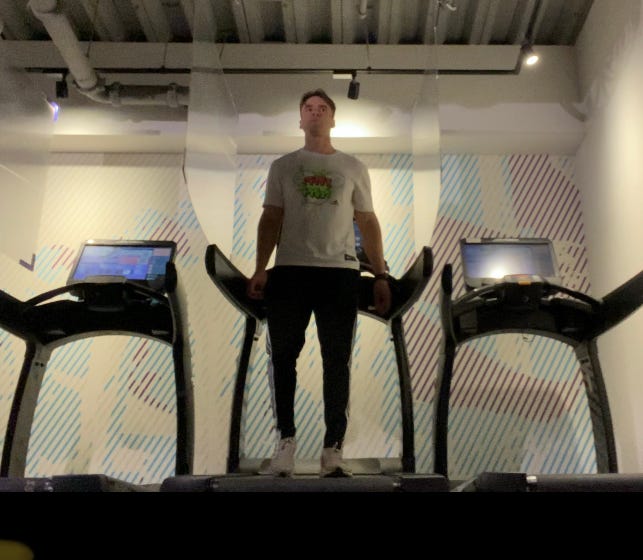 </figure><figure>
</figure><figure>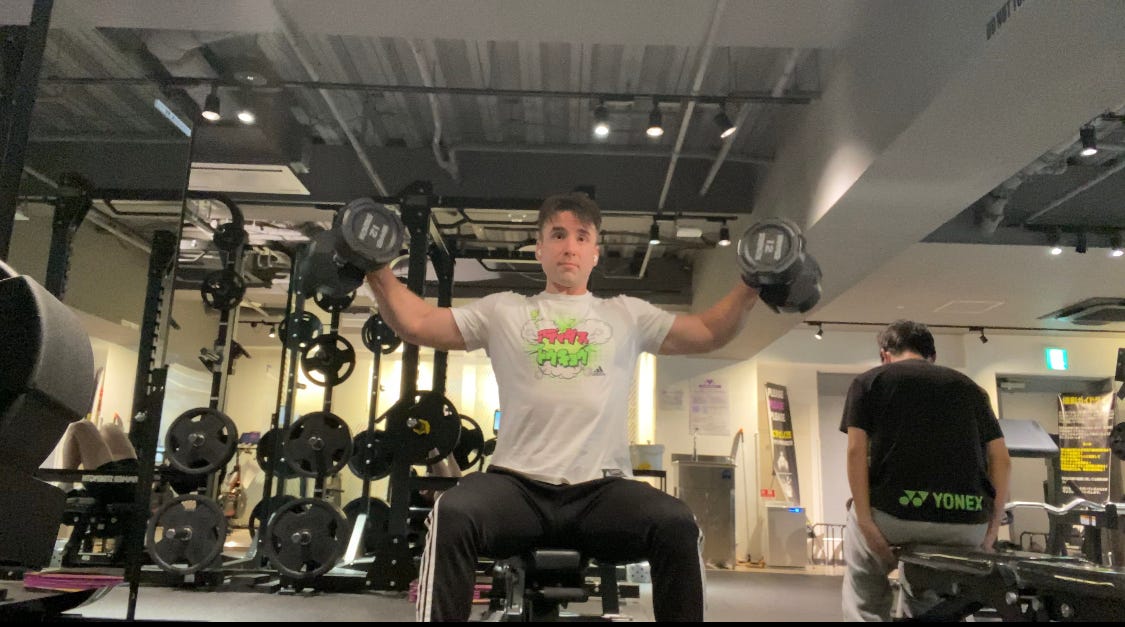 </figure>
</figure>This day I hopped on the treadmill for an hour to bang out some steps - my legs were already starting to hurt so I tried triggering different muscles by walking backwards. After that I did a shoulder workout. Unsurprisingly I was weaker than usual but wasn’t feeling terrible. My post-workout meal was about 80kcal of salted pollock roe. I had a small package of beef jerky, some LMNTs and a chocolate LMNT stirred in hot water with a dash of milk for a total of about 270 calories for the day.
<figure>Post workout recovery: 80kcal of salted pollack roe.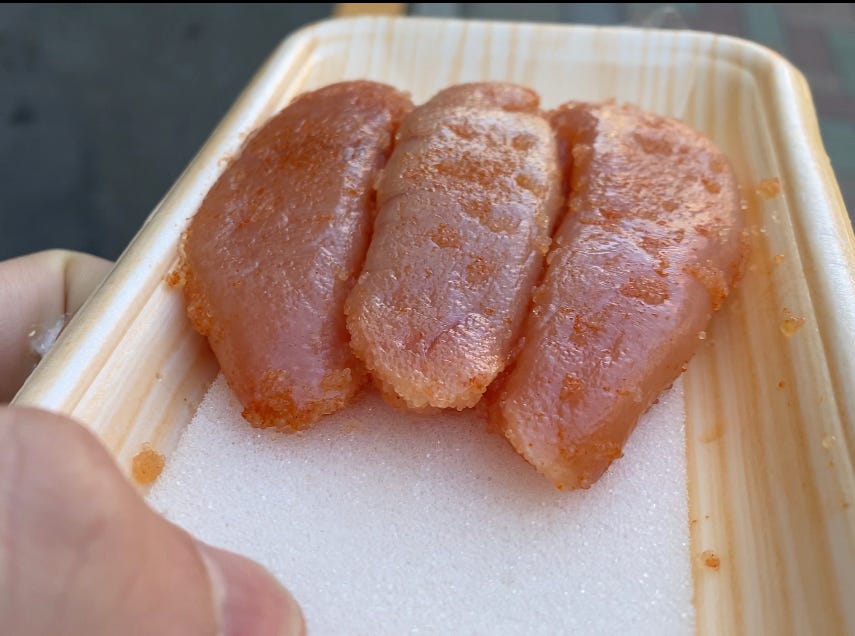 </figure><figure>Unfortunately I did not get to eat this sushi.
</figure><figure>Unfortunately I did not get to eat this sushi.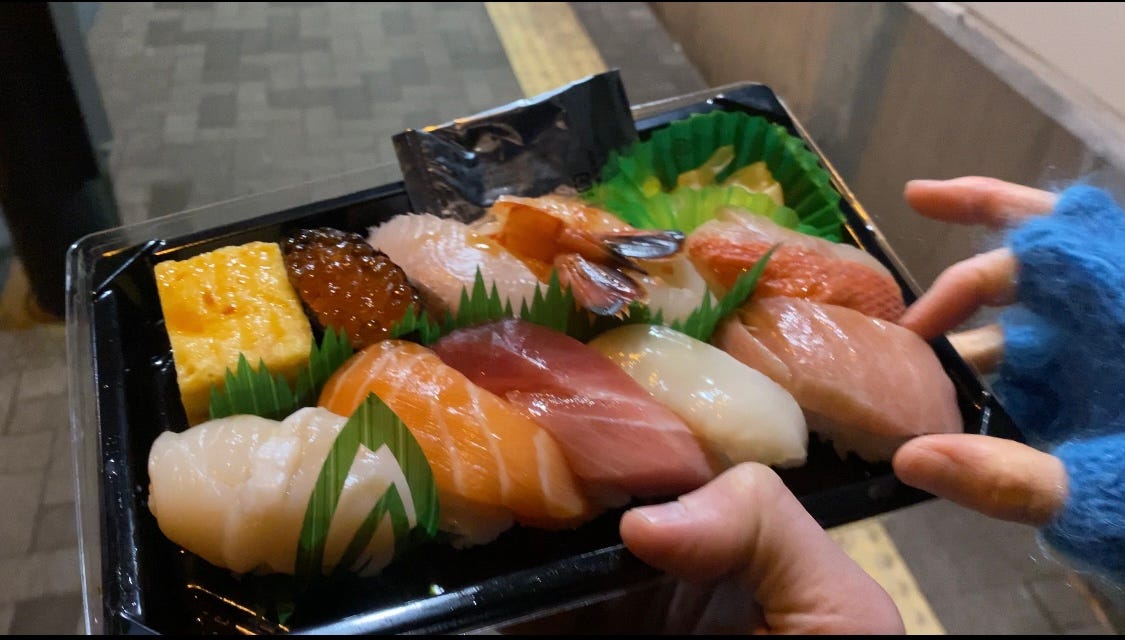 </figure>
</figure>For dinner I got to watch my girlfriend eat this nice pack of sushi I picked up. She let me lick some of the soy sauce.
Day 3
Day 3 was a lot more fun because I got to head out to Hakone-Yumoto to hike with my friend through the Old Tokaido Road to Ashinoko Lake.
<figure>Don’t worry, that’s not my can.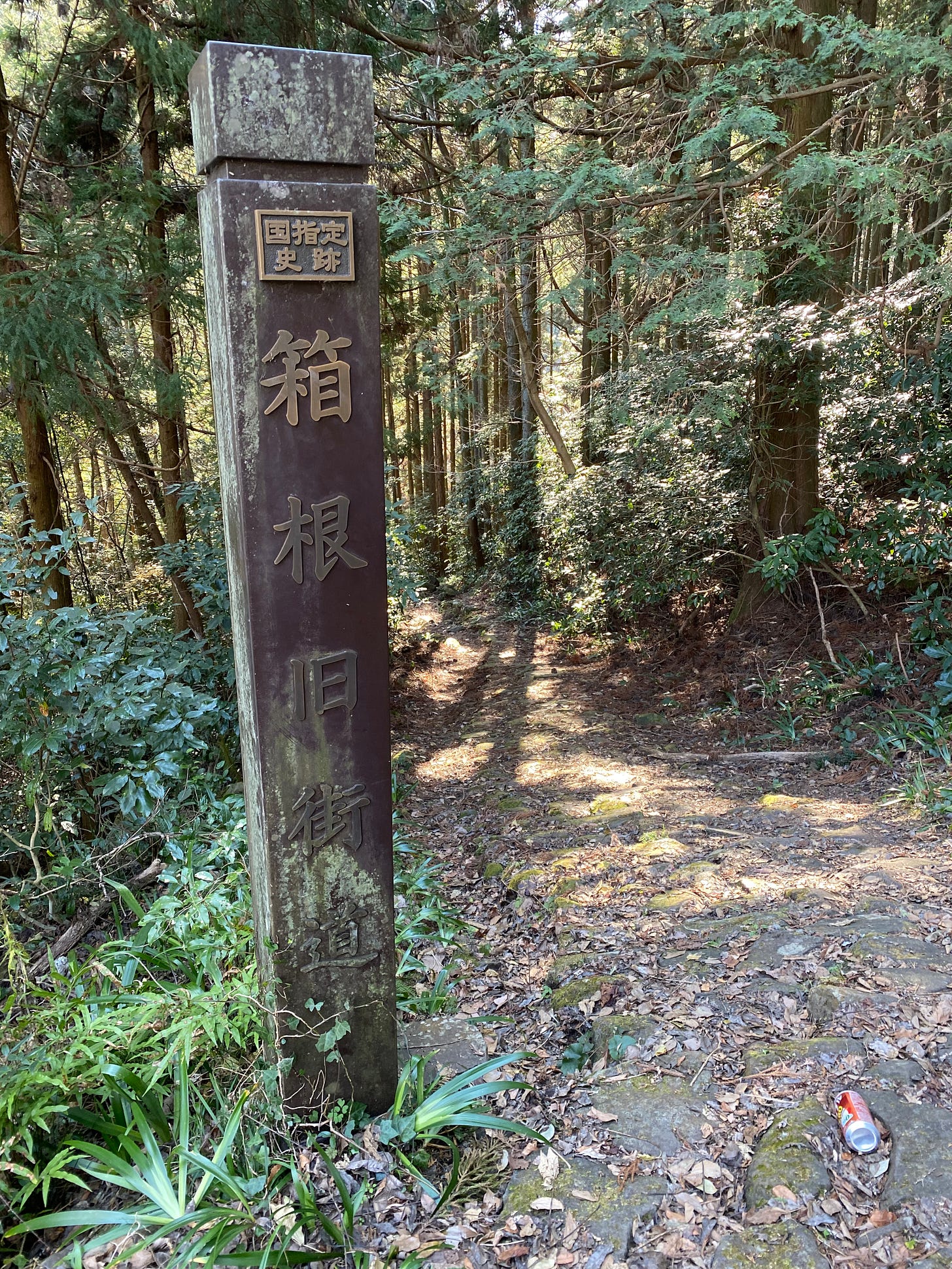 </figure><figure>
</figure><figure>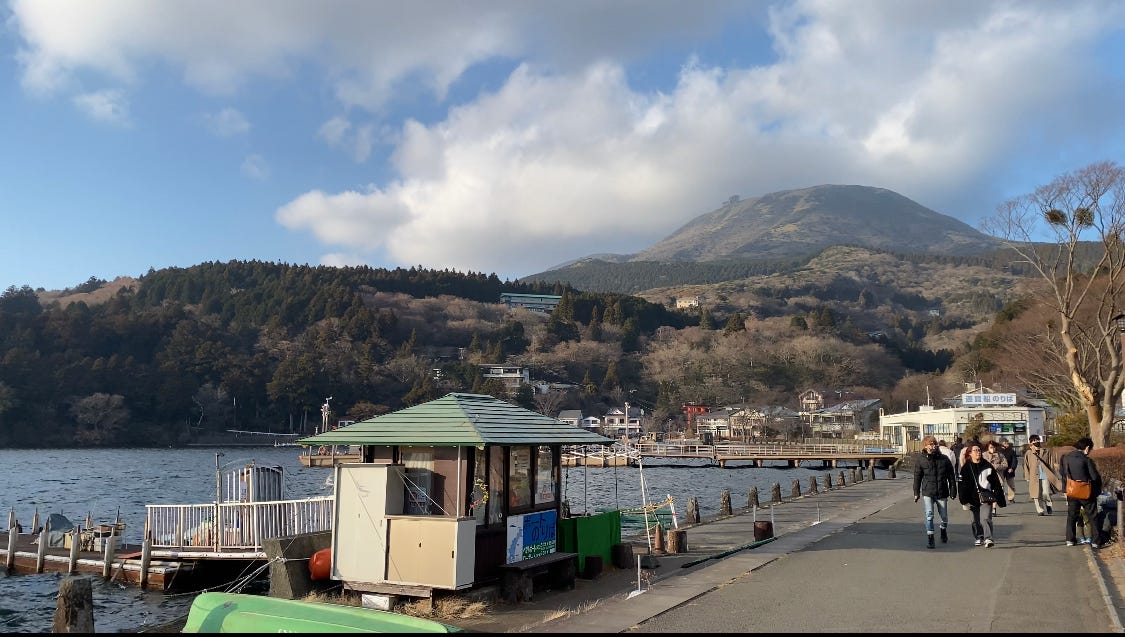 </figure>
</figure>Being in nature and being able to chat with my friend made the long walking much more enjoyable. There were many more times where I felt like I was in a flow state and not concerned about how tired my legs were or how hungry I was. On that note, one study from Stanford and UCSF found that people who did a 50-minute walk in a natural environment were less likely to ruminate and have anxiety than people who did that walk in an urban setting.
<figure>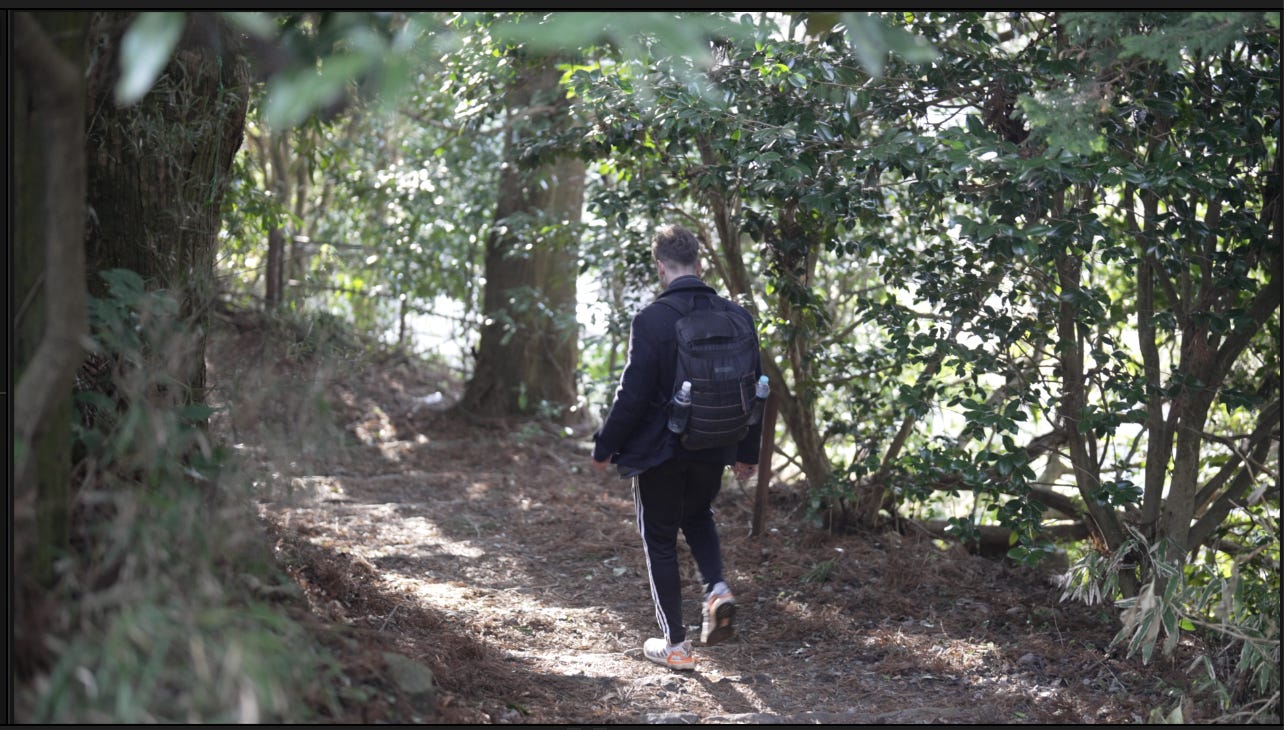 </figure>
</figure>For the most part the movement seemed to silence the hunger to where whenever I wasn’t feeling too great, it was more because I really just wanted to sit down - not so much the hunger.
<figure>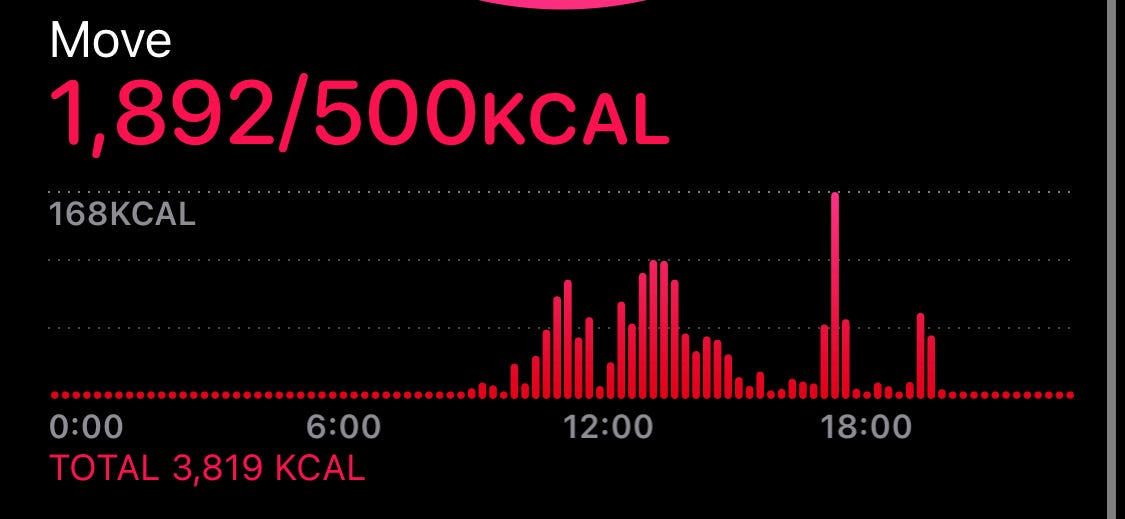 </figure><figure>
</figure><figure>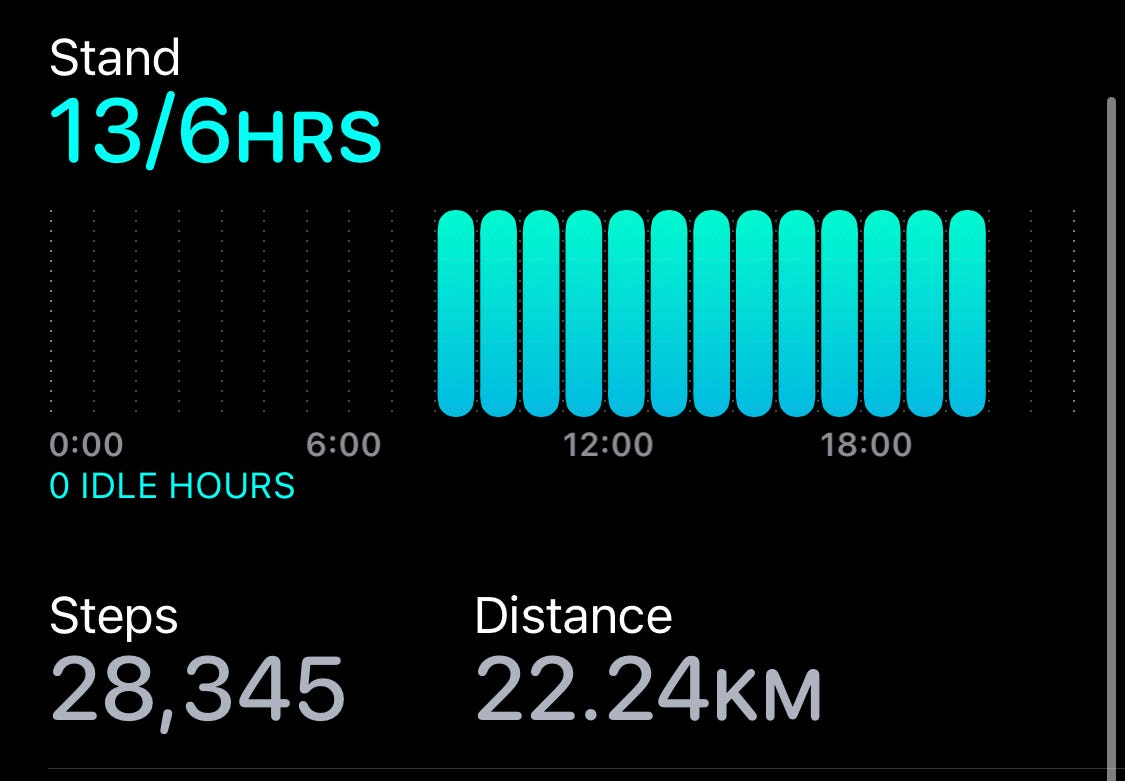 </figure>
</figure>I tried going for a run and I actually felt quite energetic and very light, but after 3 kilometers I started to get a headache and switched to walking.
<figure>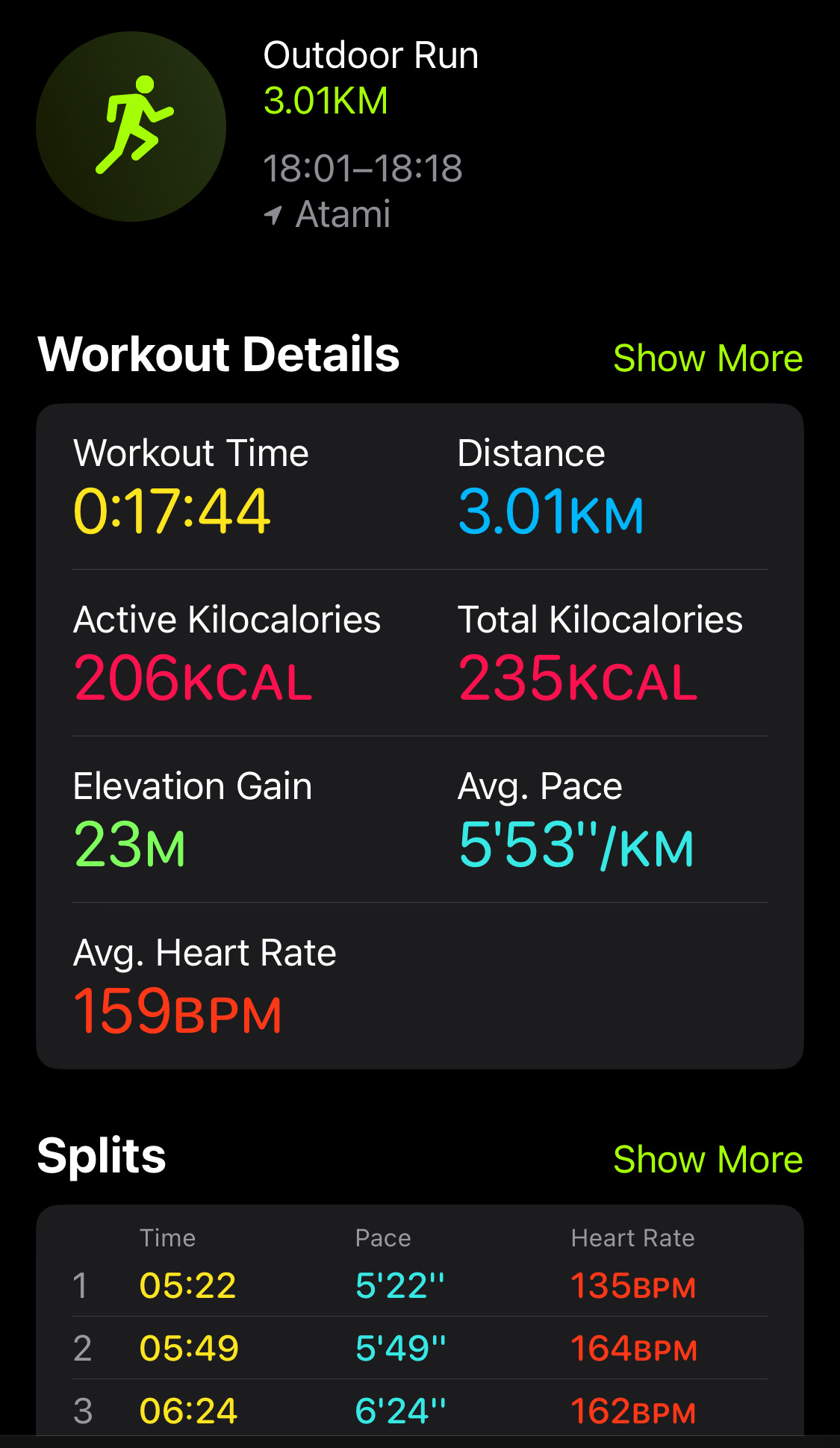 </figure>
</figure>Usually by this point in a fast, the twinge in your stomach makes it hard to fall asleep, but like the day before, I was so exhausted that I fell asleep much faster than I usually do when I’m eating.
<figure>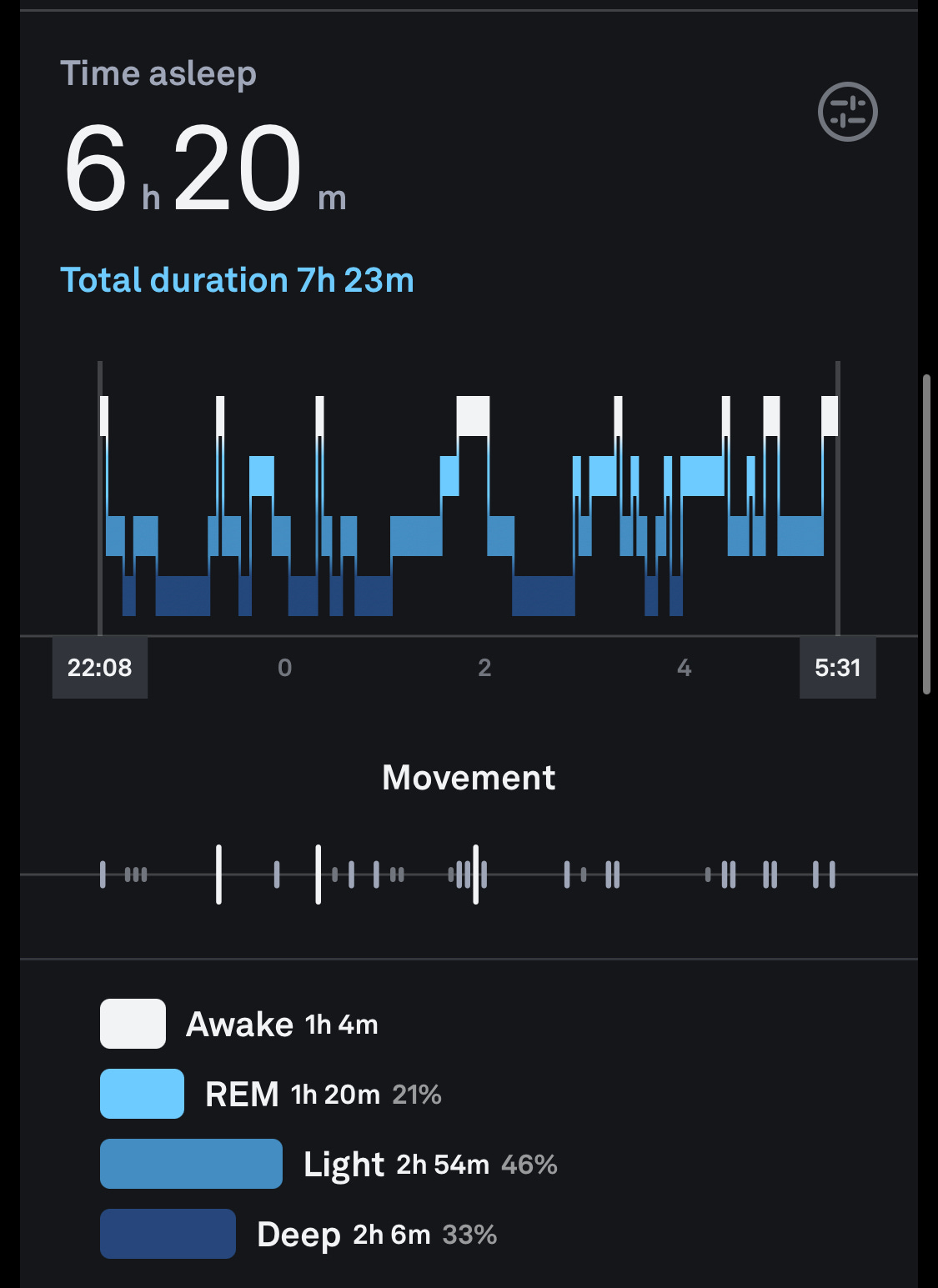 </figure>
</figure>My sleep data shows I rustled myself asleep a couple times, but my sleep at the hotel wasn’t particularly bad compared to my usual sleep.
On this day, I felt my best right after taking a dip in the cold stream in the forest.
<figure> </figure>
</figure>Synergy between Fasting, Exercise and Cold Exposure
There is a surprising amount of synergy between fasting, exercise and cold exposure. Let me lay out the points of overlap and then we’ll get into more detail:
<figure>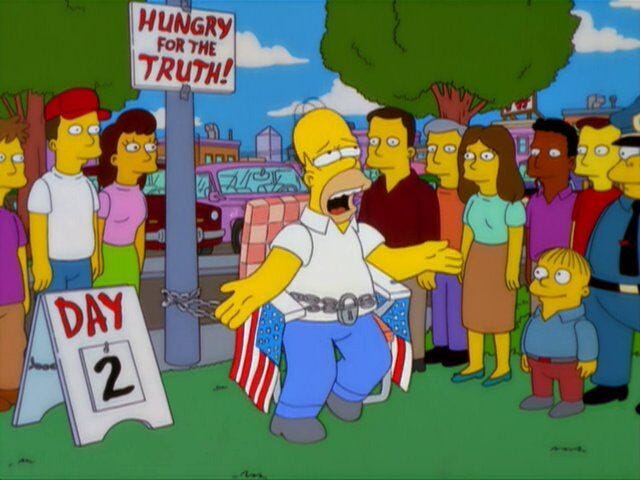 </figure>
</figure>Fasting
・The typical aims of fasting are to lower blood sugar, deplete glycogen, lower insulin and increase ketone output.
Exercise
・Exercise speeds up the depletion of glycogen.
・Low intensity exercise decreases insulin and increases insulin sensitivity.
・Exercise increases ketones and increases the capacity of muscles to extract ketones from the blood. (R2)
Cold exposure
・“In healthy individuals, cold exposure can increase energy expenditure and whole body glucose and fatty acid utilization. Repeated exposures can lower fasting glucose and insulin levels and improve dietary fatty acid handling, even in healthy individuals.”(R)
・Cold exposure is shown to increase insulin sensitivity (R2, R3)
・There is animal research suggesting cold exposure increases ketones and that cold adapted rats have increased ketone production.
As I’m sure you’re aware, many of the benefits that come from fasting stem from reducing insulin. When you fast, your blood sugar goes down which causes insulin to go down and by maintaining this low insulin state, your ketone levels start to increase significantly.
<figure>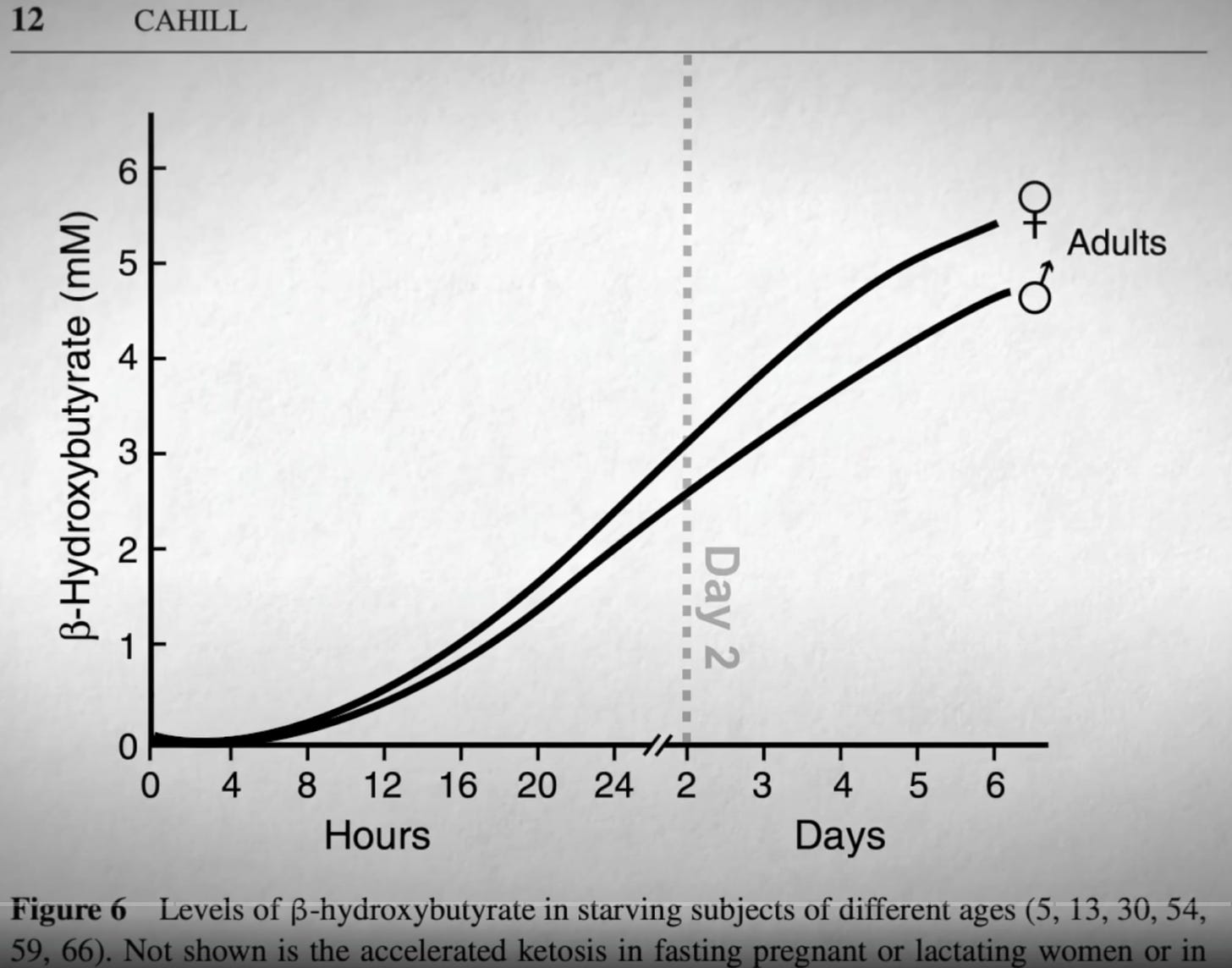 </figure>
</figure>I had been doing brief cold showers the first and second day but on the 3rd day when I was out hiking with my friend and took the opportunity to hop in the cold stream. It was quite cold - cold enough to be a challenge and make me shiver, but not quite as cold as an ice bath.
Both and exercise and cold exposure have been found to increase ketones. This may in fact make it easier to stand the cold because one of the ways cold exposure will help you burn fat is by turning more of our fat into brown fat.
<figure>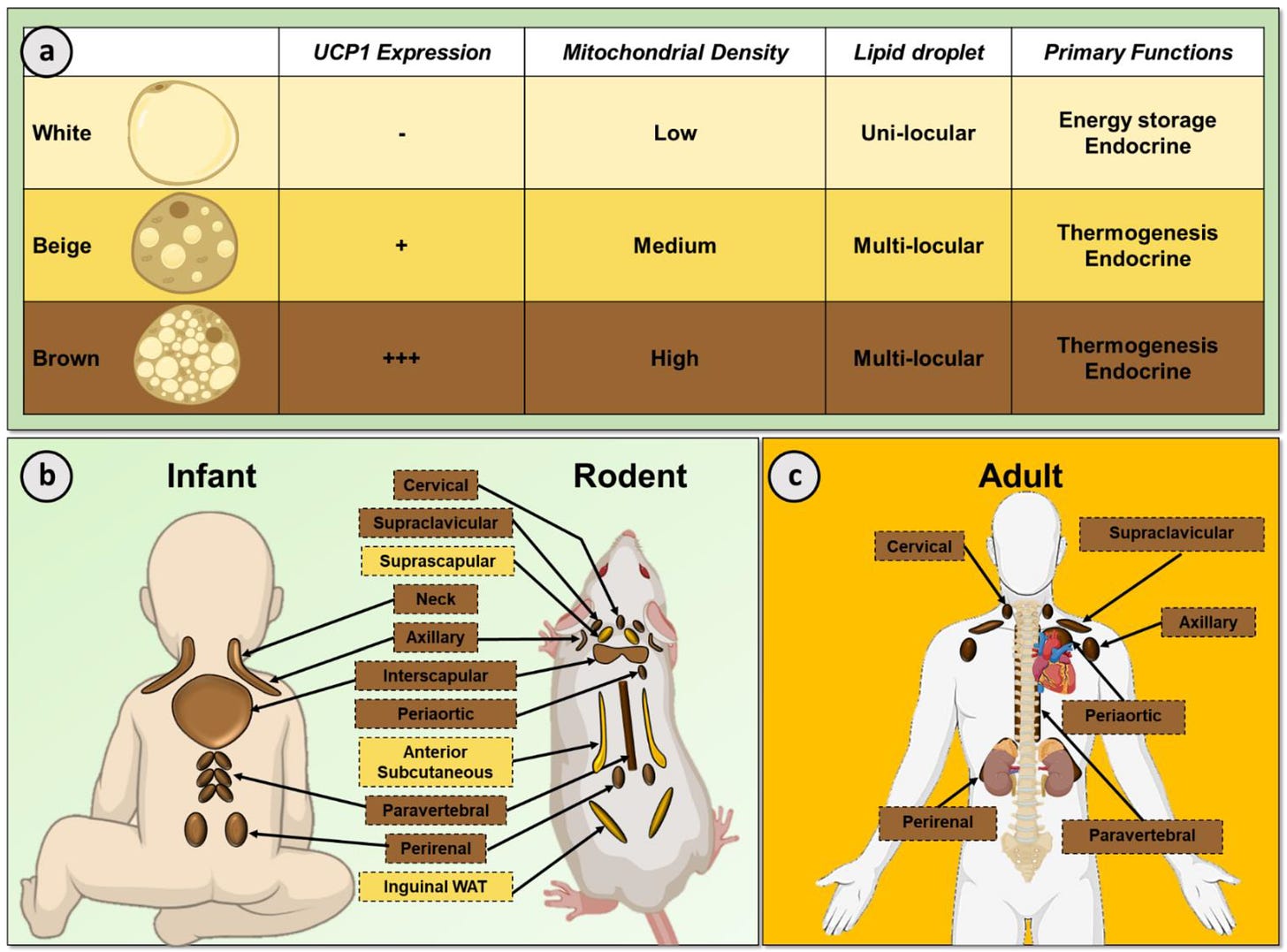 </figure>
</figure>There are two types of fat - white adipose tissue and brown adipose tissue. Brown fat appears brown because it has far more mitochondria.
<figure>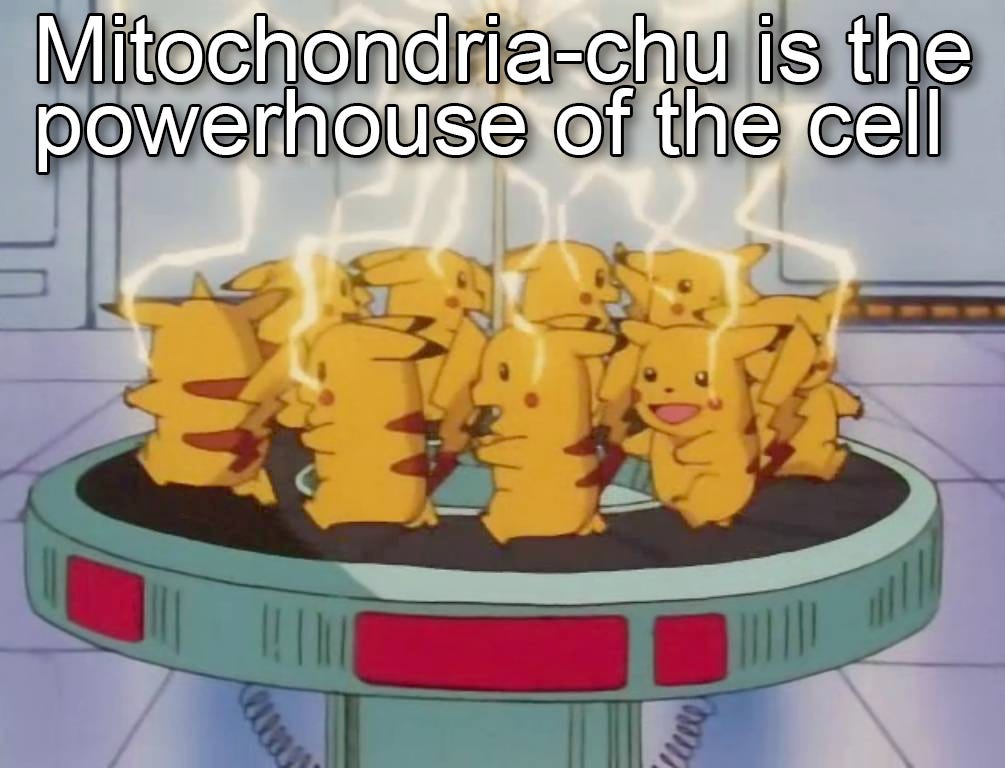 </figure>
</figure>We normally think of fat as just a vat for storing calories, but the purpose of this brown fat is to act like a furnace, keeping you warm by burning up calories in its mitochondria. The more you expose yourself to the cold, the better this brown fat gets at burning calories for heat to keep you warm. The body can become remarkably good at this to the point that you get people like Wim Hof staying in full-body contact with Ice for 1 hour and 44 minutes. (The record has since been broken many times and stands at 3 hours by Polish Scientist Valerjan Romanovski)
<figure>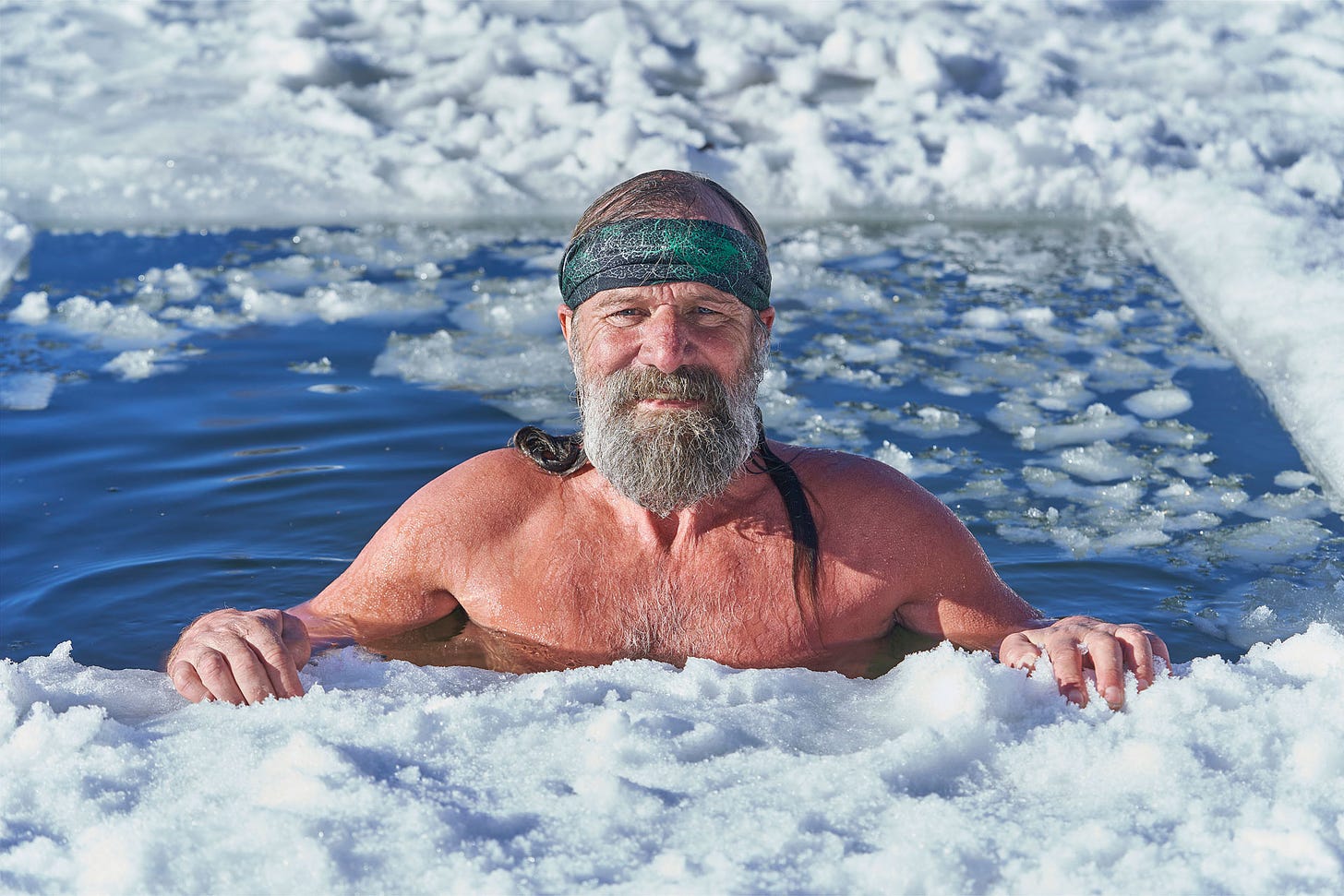 </figure>
</figure>Better yet, Dr. Benjamin Bikman has found that when you apply ketones to fat cells, it increases their ability to burn calories and that ketones convert white fat into brown fat. In mice, a ketogenic diet has been found to increase the size of the mitochondria in brown fat.
On the other side of ketones, we have insulin. Where ketones to tell your fat to burn more calories, the hormone insulin tells the fat to just store the calories. And, insulin will block your fat cells from turning into this more productive brown fat and will increase the amount of white fat you have. Lucky for us, exercise and especially fasting will lower insulin. This is good also because studies have suggested that higher insulin reduces your body’s daily calorie burn.(S, S2)
Dr. Bikman has also said that more of this active brown fat can increase your daily calorie burn and that just being in ketosis can increase your daily calorie burn by about 200 to 300 calories.
Associate professor Wayne B. Hayes has invented a cooling vest designed to help you lose weight. Through your body’s attempts to heat your body up in response to the cold, Hayes claims the vest can have people burn as much as 250 calories per hour. He got the concept from Ray Cronise who claims a regimen of cold showers and shirtless walks in winter had him lose 26.7 pounds in six weeks.(S)
Day 4
I did a sauna session the night before (I don’t recommend doing sauna while fasting) and I woke up in the morning around 5:30 with blood sugar lower than usual (a tad over 50). I felt extra drained and had this heaviness in the chest that I associate with low blood pressure.
<figure>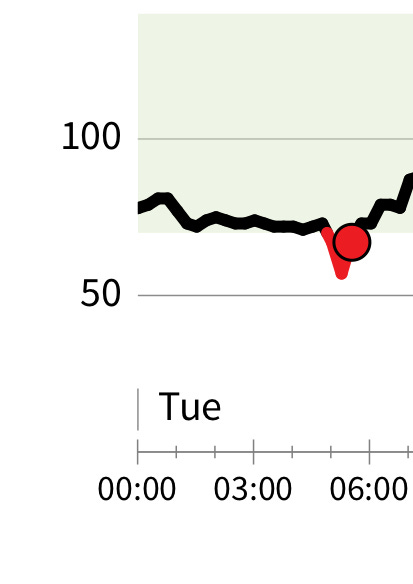 </figure>
</figure>A bit of salt with electrolytes cleared that up pretty quick and I was feeling awake and ready to get out of the hotel. I got in 10,000 steps and listened to an Andrew Huberman podcast while my buddy slept.
<figure>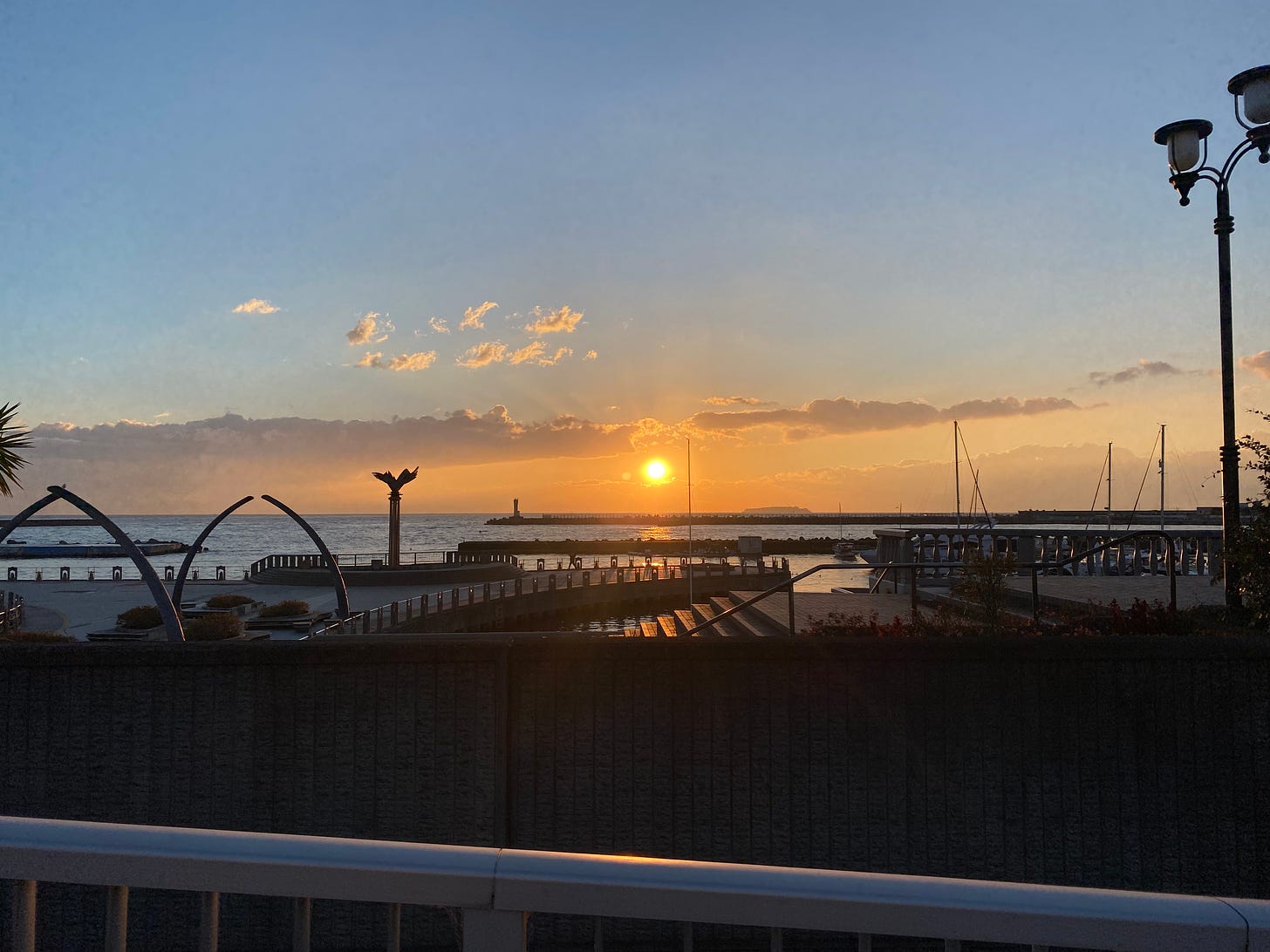 </figure>
</figure>I learned from that podcast that getting in icy water that is as cold as you can stand and purposefully relaxing in a way to prevent yourself from shivering may not be the best way to burn fat. It will induce the benefits of cold adaptation I discussed above, but may not be the optimal strategy if you’re specifically trying to burn fat. Huberman says that a very effective way to induce fat loss from cold exposure is specifically to shiver. Shivering causes the release of something called succinate. This succinate acts on the brown fat to increase the brown fat’s production of heat and therefore calorie burn.
shivering is a strong stimulus for the release of adrenaline into fat and the increase in fat oxidation and mobilization.
Shivering also triggers adrenaline release from neurons of the sympathetic nervous system that are embedded in fat. This causes fat to be released and burned for energy.
<figure> </figure>
</figure>With all this in mind, I went down to the beach and got myself into the very cold sea. Per Huberman’s recommendation, I got in for 3 minutes, let myself air out in the cold air for 3 minutes, and got back in for another 3 minutes - repeating this for 12 minutes. Even after I put my clothes on, I was still shivering like a wet chihuahua as we walked down to the Sukiya to get me some miso soup.
<figure>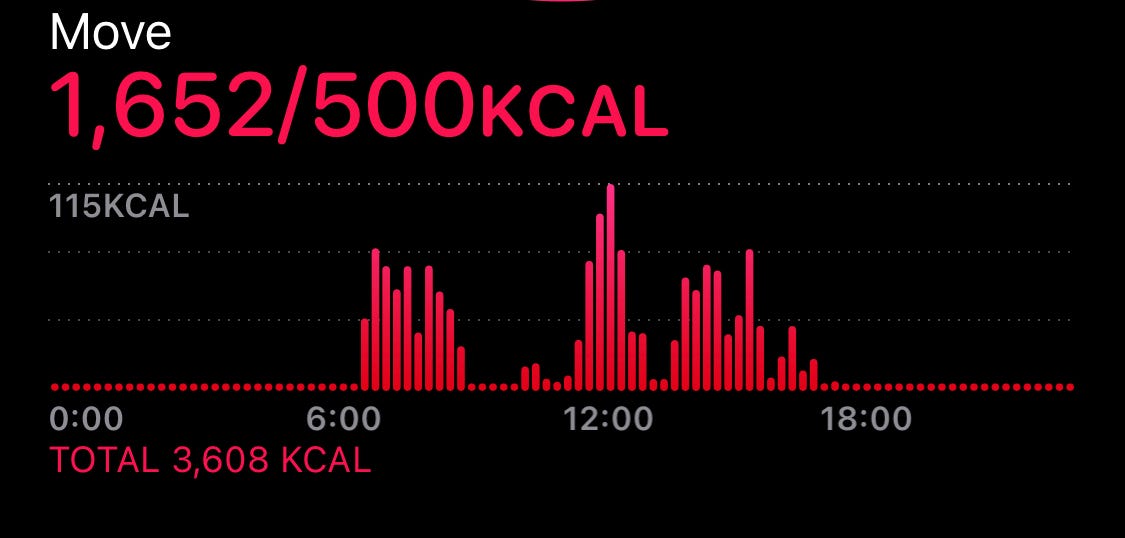 </figure><figure>
</figure><figure>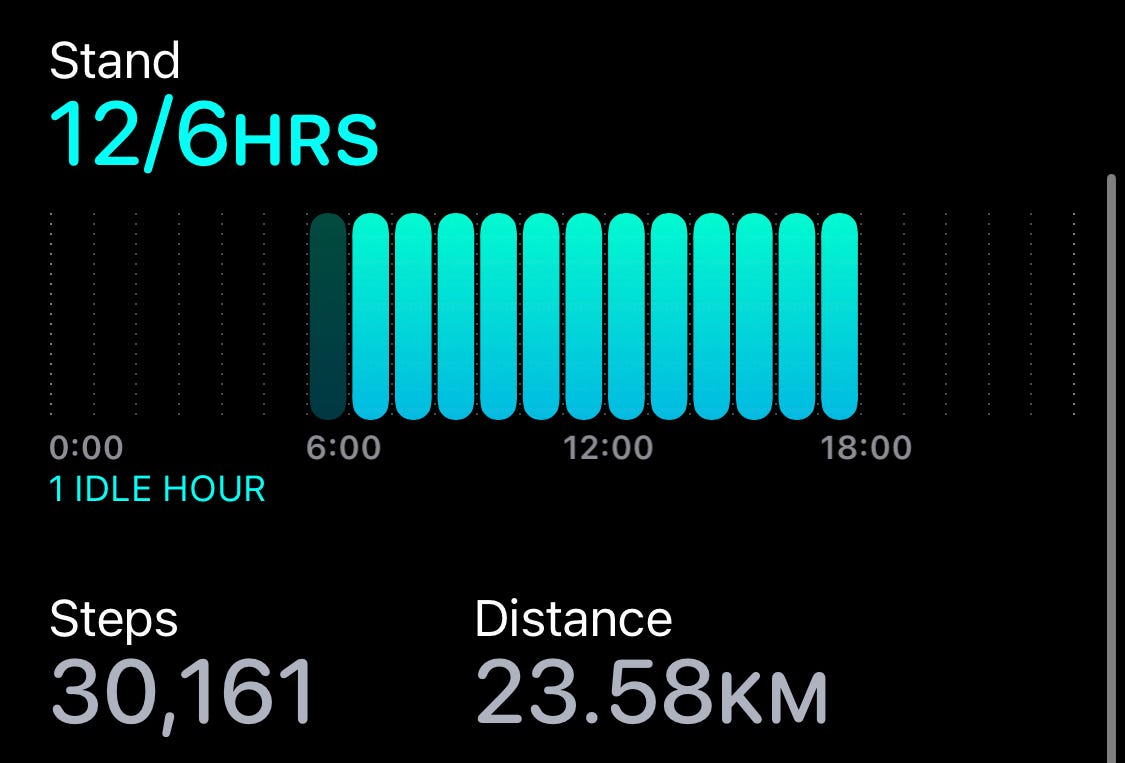 </figure>
</figure>Despite not having as much time to walk this day, I was once again totally exhausted and ended up being knocked out in bed about 11 and a half hours. (The following data from the Oura app didn’t record the nap that I took a little while after waking up at 6)
<figure>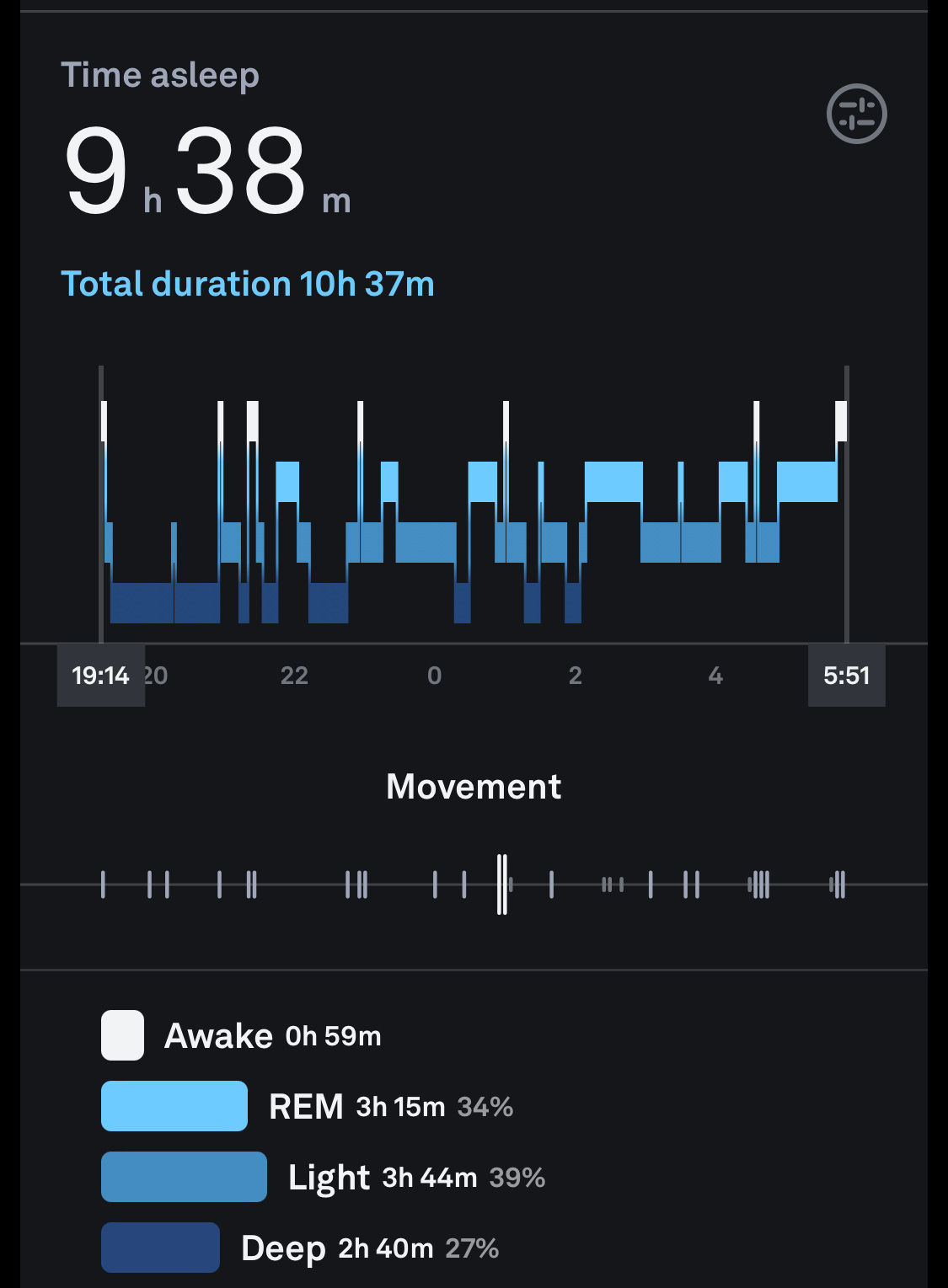 </figure>
</figure>Day 5
The last day, we hopped on the train to go back to Tokyo and while I was aiming to max out my steps, my achilles heal was killing me and was limping along most of the day.
It didn’t seem to be too bad if I was walking on a perfectly flat surface, so I went to the gym and did an hour on the treadmill while watching a bad Michael Bay movie - The Island. Eventually my achilles started hurting a lot despite the steady treadmill so I had to call it quits after a measly 25,000 steps.
<figure>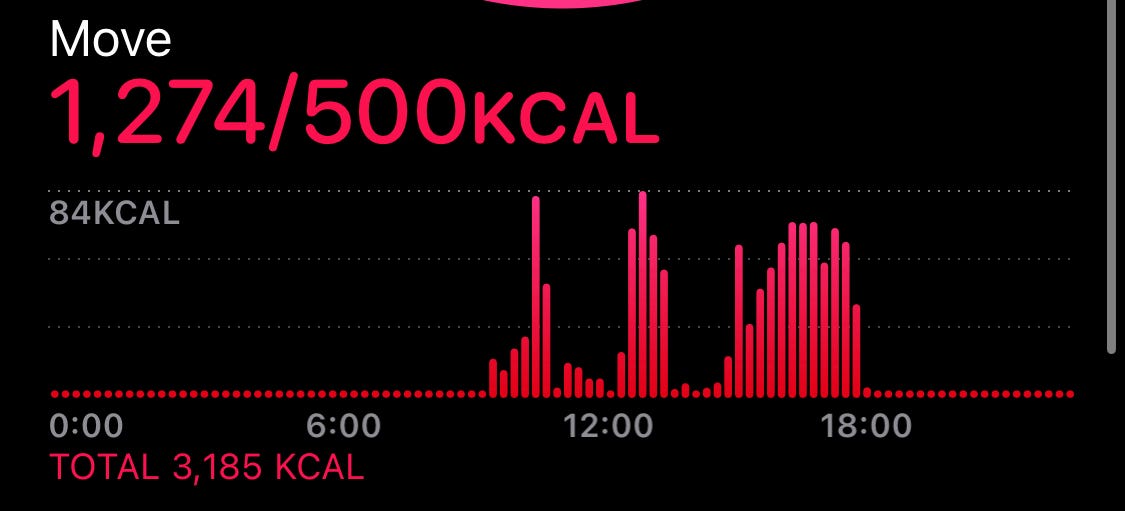 </figure><figure>
</figure><figure>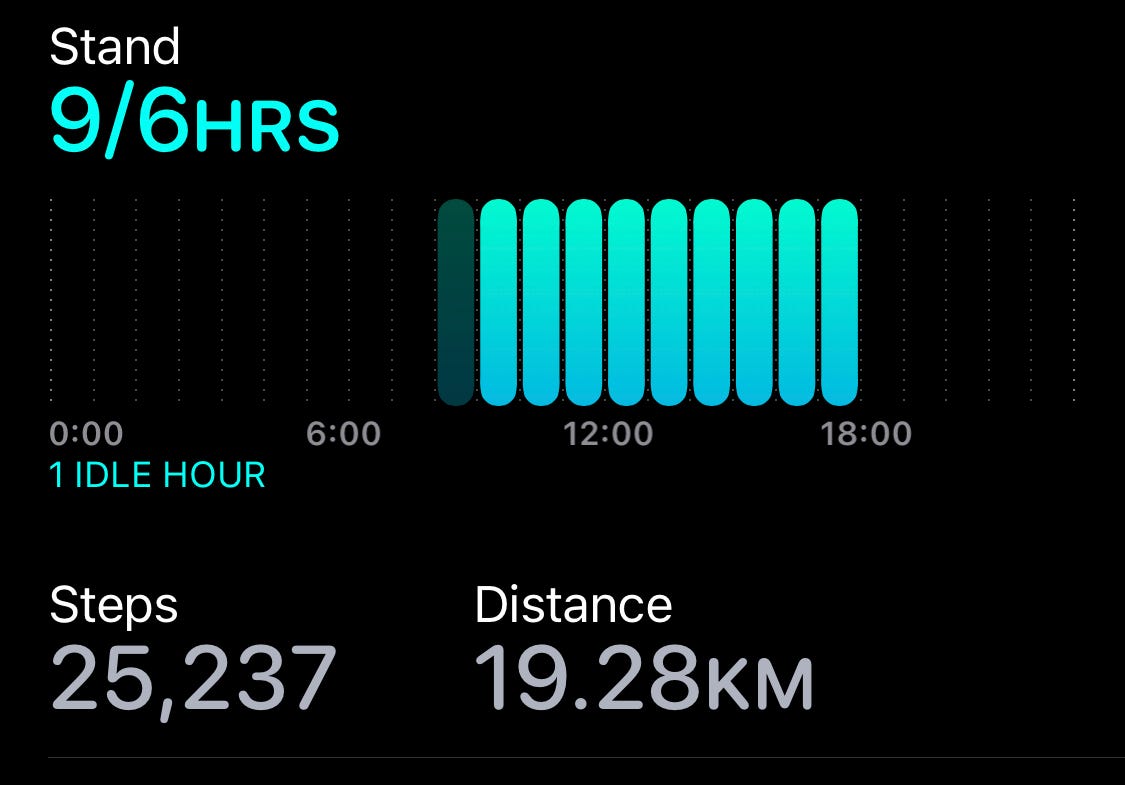 </figure>
</figure>Breaking the Fast & Results
This day, I limped out another 15,000 steps, took the after picture, got my blood drawn again and broke my fast with a nice big ribeye.
<figure>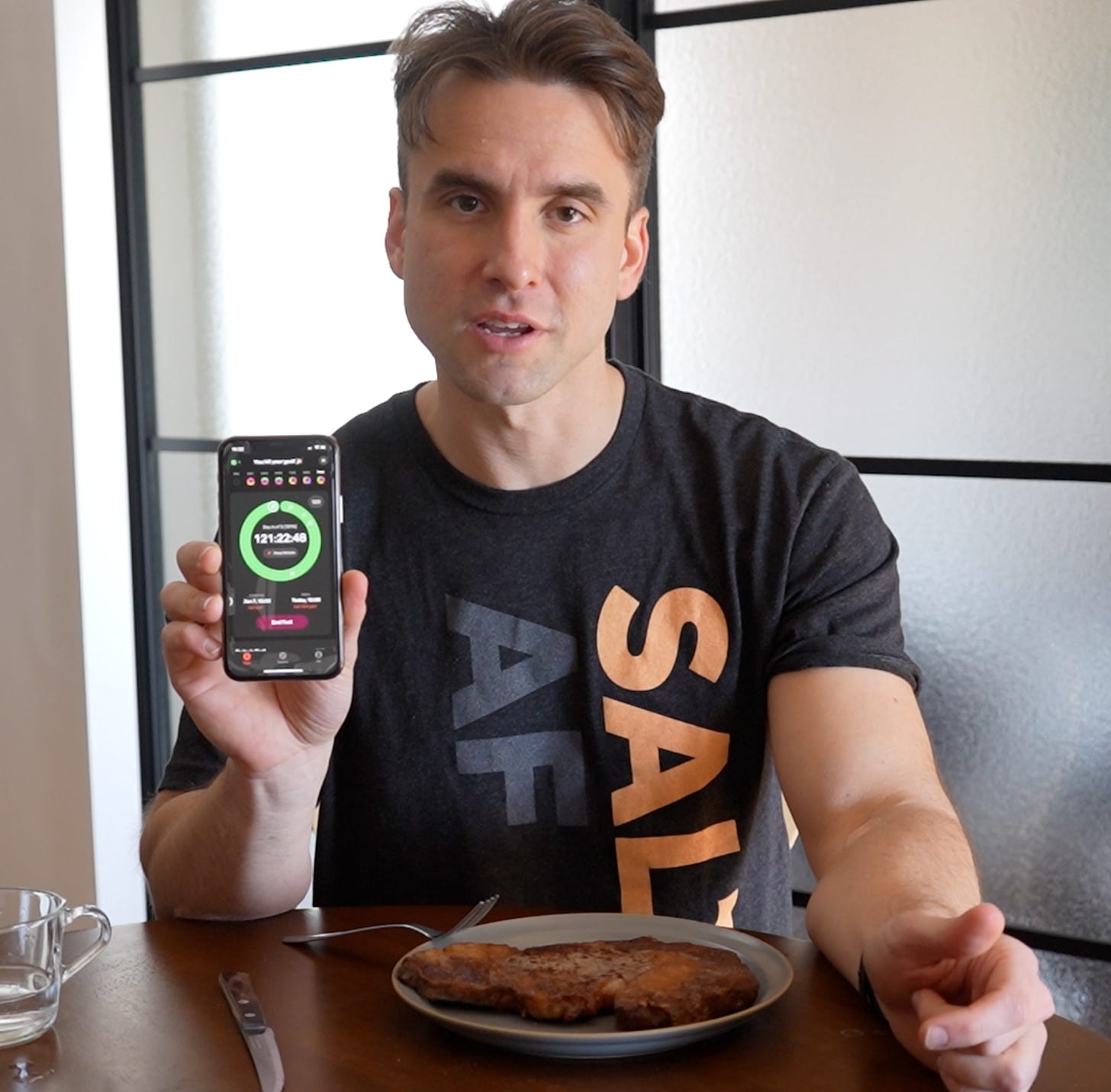 </figure>
</figure>Before and After Pictures
<figure>Before </figure><figure>After
</figure><figure>After </figure>
</figure>The side view is more impressive:
<figure>Before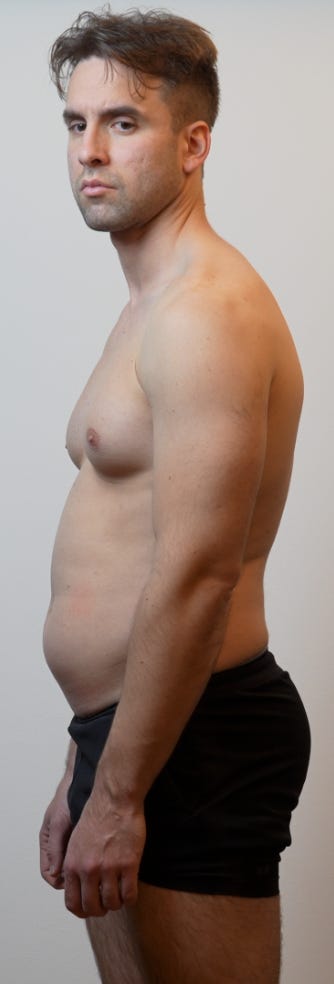 </figure><figure>After
</figure><figure>After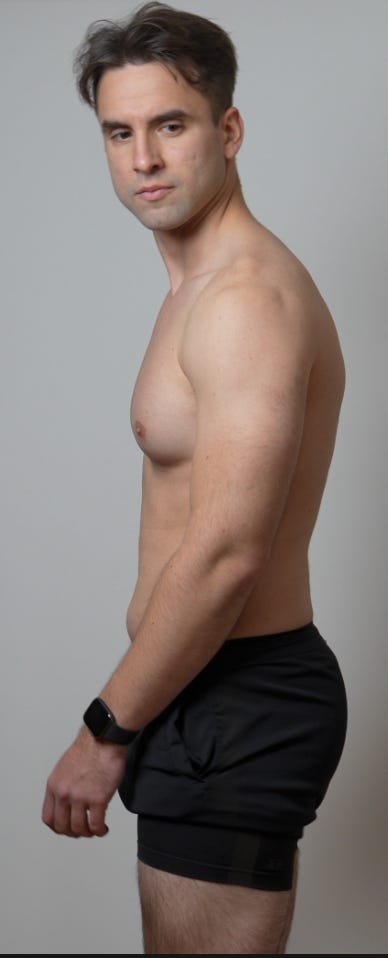 </figure>
</figure>Weight
<figure>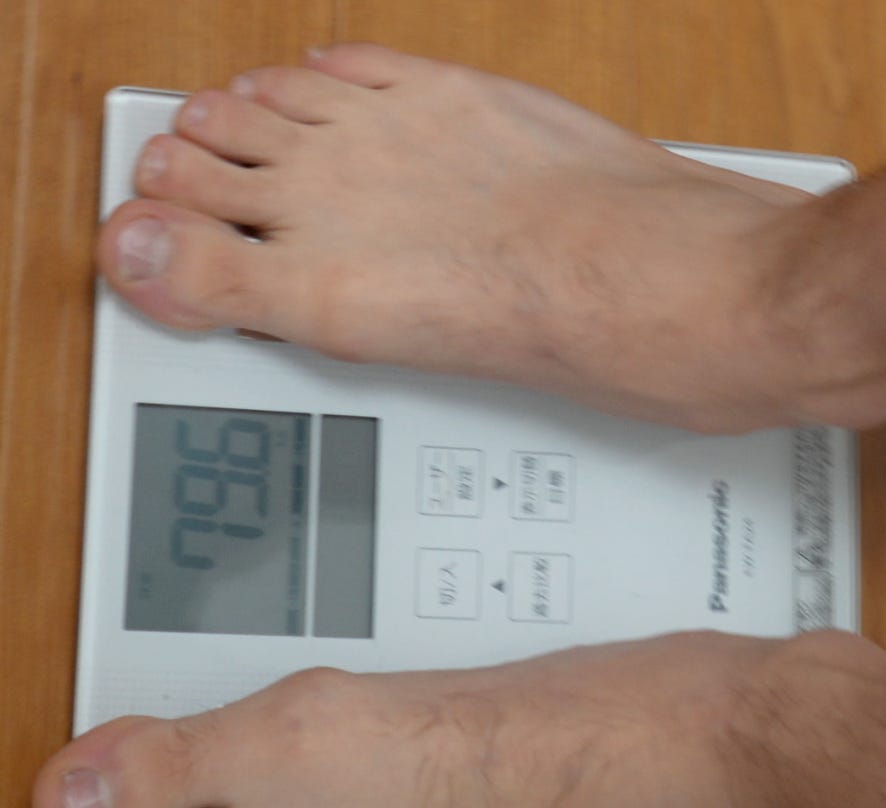 </figure>
</figure>Weight went down to 79.6kg (175.5lbs) meaning I lost 5.3kg or 11.7lbs.
Blood Results
[Before]
<figure> </figure><figure>
</figure><figure> </figure><figure>
</figure><figure> </figure><figure>
</figure><figure> </figure>
</figure>[After]
<figure> </figure><figure>
</figure><figure> </figure><figure>
</figure><figure> </figure><figure>
</figure><figure> </figure>
</figure>To sum up:
Insulin reduced 3x
CRP (Inflammation) reduced 1.8x
IGF-1 reduced 1.7x
White Blood Cells reduced 1.65x (as discussed earlier, this may indicate an increase in autophagy)
So it seems I indeed achieved all the goals I had for this fast despite my daily 300kcal snack
Here are my blood lipids:
Before
 </figure>
</figure>After
<figure> </figure>
</figure>I’m not worried about high LDL cholesterol, but the slight improvement in HDL and reduction in triglycerides was nice.
<figure>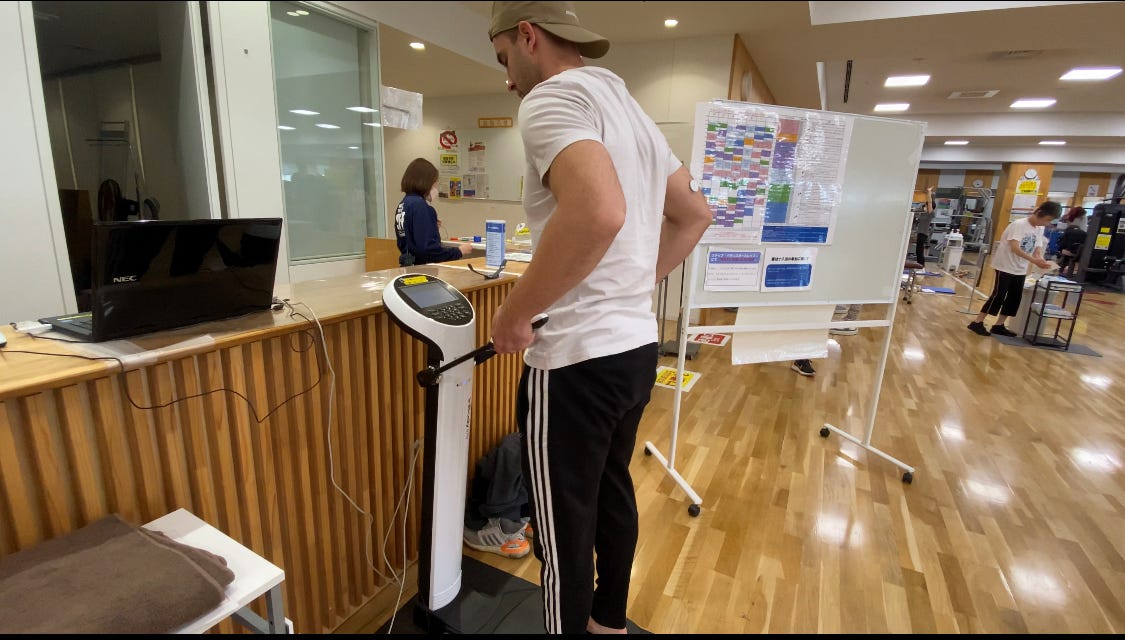 </figure>
</figure>Body Composition Change
Let me warn you, that the last time I got an InBody scan, it said my body fat percentage was 6% when I looked like this:
<figure>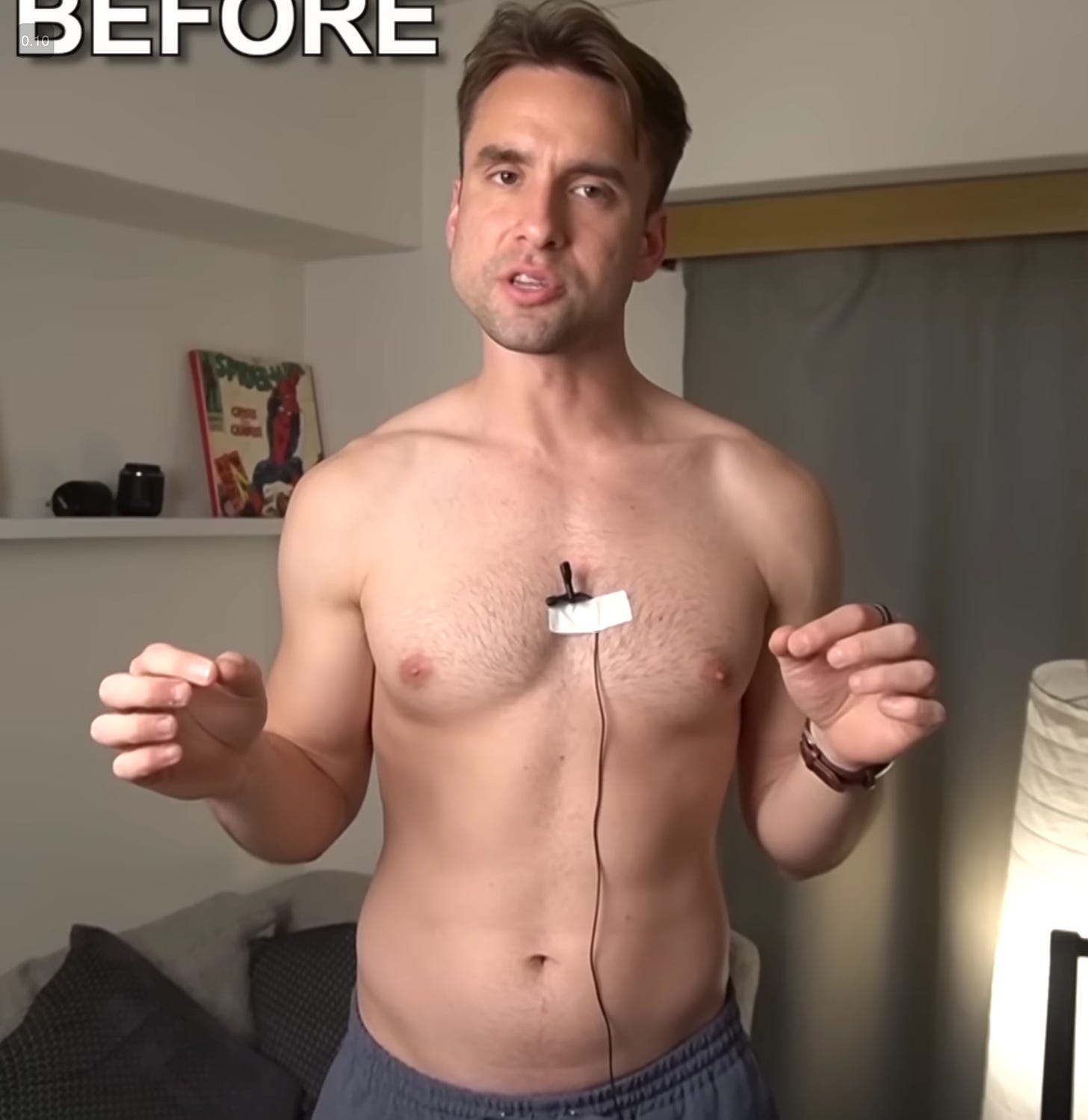 </figure>
</figure>So, honestly I really doubt the InBody’s accuracy. Most body fat percentage comparison graphics don’t seem very consistent at all, but for reference, this is what 6% body fat allegedly looks like.
<figure>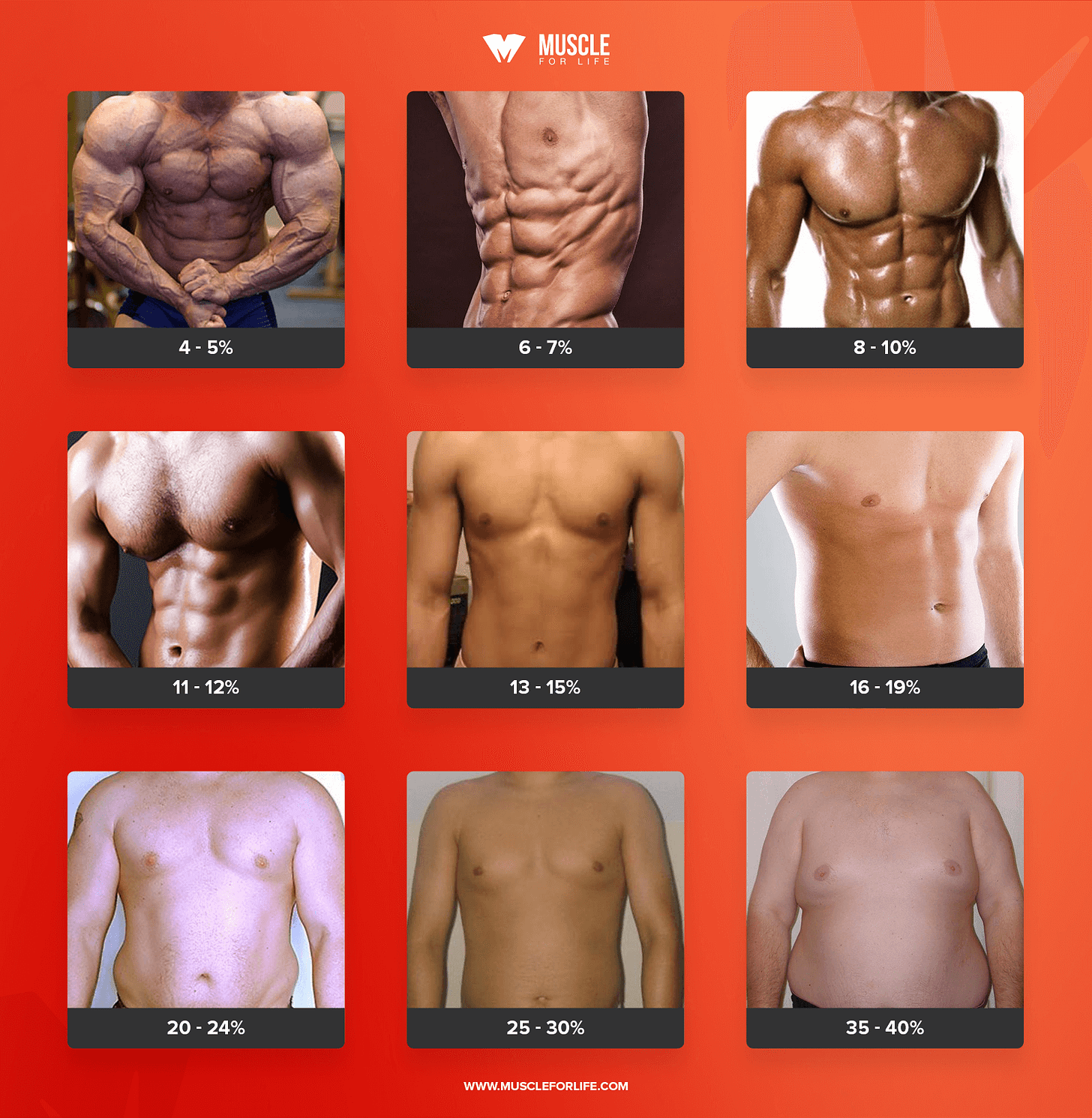 </figure>
</figure>Regardless, I thought I would give the InBody a shot. I figured if it was going to over or underestimate my actual body fat % it would be doing it before and after the fast, so it might still give us some insight into how my body fat and muscle mass changed through the fast. I did an InBody scan about 1 hour before I finished my last meal on the 7th and about 2 hours before I broke my fast on the 12th.
So, with a big grain of salt, here are the before and after results:
Before
・Soft Lean Mass: 70kg (154.3lbs)
・Body Fat Mass: 9.9kg (21.8lbs)
・Body Fat Percentage: 11.7%
After
・Soft Lean Mass: 68kg (149.9lbs)
・Body Fat Mass: 7.4kg (16.3lbs)
・Body Fat Percentage: 9.3%
I’ll take the 2.5kg (5.5lbs) reduction of body fat, but that 2kg(4.4lbs) soft lean mass reduction is not too exciting. However, this doesn’t necessarily mean I simply lost 2kg of muscle. Soft lean mass apparently refers to the sum of your total body water, protein and non-bone minerals. So I wouldn’t be surprised at all if my total body water is lower since we tend to lose a lot of water weight when fasting or doing a keto diet.
<figure>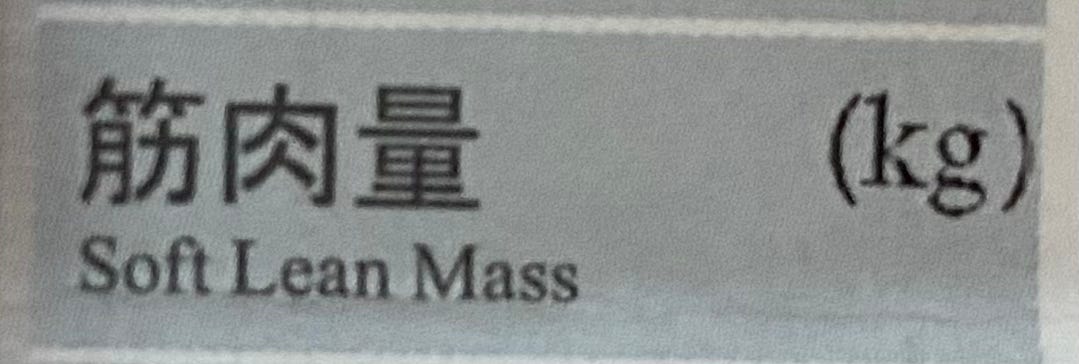 </figure>
</figure>Since my report just says 筋肉量 (muscle mass) beside “soft lean mass,” I think these devices can misguide people into believing they lose too much muscle on a fast or when they’re dehydrated. However, in this study using a DEXA scan (thought to be the gold standard for measuring body composition) to check fat mass and lean mass in people undertaking a 10-day fast, they found that the people’s fat mass drastically reduced by day 6 and their lean mass was temporarily reduced by day 6 of fasting. However, their lean mass returned back to baseline after 5 days of refeeding while maintained their reduction in fat mass.
<figure>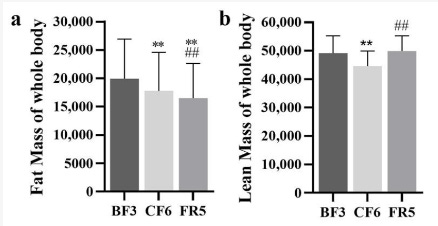 </figure>
</figure>Takeaways
One reality of fasting is the hunger boredom. You won’t necessarily have a huge terrible painful hole in your stomach, but you will be BORED. When you’re fasting, nothing sounds as fun as food! It’s like leaving a kid with a cup and ball to play with after he’s used to playing 12 hours of Call of Duty a day.
However, I’d say a huge takeaway from this experience is if you’re fasting, the two biggest ways to deal with feeling bad while fasting are getting out and doing some low intensity exercise and, as usual - taking salt and electrolytes. While this fast had many of the familiar challenges, it was honestly so much easier with all the walking. In fact, it was only when I stopped walking that I would start to get that ‘I’m bored - all I’m interested in is food’ agony.
I know it’s not realistic for many people to walk 7 hours a day, but simply having something you have to do is important. Myself included, most people would assume that what you want to do for a fast is to clear your schedule because you’re not going to have any energy on a fast so you don’t want to have any obligations because you might not end up performing. I mean you should definitely skip your crossfit sessions while fasting, but having nothing to do will surely make the fast twice as hard and free up your mind to focus entirely on how much you want to eat. When I did a 7 day no calorie fast, the days when I had work that I had to get done were the easiest.
How to make a fast easier:
- Stay busy
- Do plenty of low-intensity exercise
- Get in nature
- Get plenty of sun
- End your last meal around 1PM, not night
- Do hard (but not too hard) things
- Take salt and electrolytes
- Don’t torture yourself
What I mean by #8 is: If being able to eat a 100 calorie miso soup will allow you to fast for 5 days instead of 3, just eat the damn soup. As you can see from my blood results, I indulged in a whole 300 calories per day and still got great results for insulin, inflammation, IGF-1 and (most likely) autophagy.